#they’re also positioned similarly to how they are in the main key art!
Explore tagged Tumblr posts
Text
Happy anniversary to one of my favorite niche games of all time, Bendy in Nightmare Run!
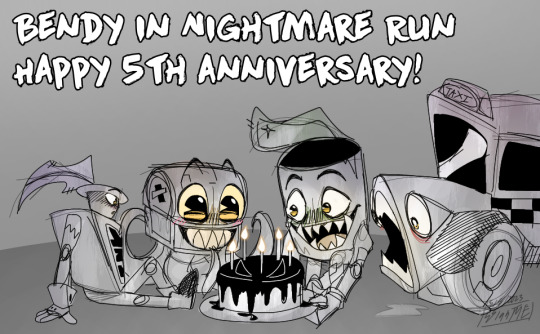
Honestly surprised it’s five years old at this point- and although it has been forgotten, I’m still very attached to these guys! And tbh it’s also a goal of mine to become “the BINR artist”
Happy anniversary once more to these rugged lads!
Bonus:

#they’re also positioned similarly to how they are in the main key art!#cake included (even if it’s not actually bendy)#digital art#vian's art#bendy in nightmare run#batdr#batim#binr#binr dewey#binr chester#binr canoodle#binr gaskette
65 notes
·
View notes
Text
Feminist Relevant Themes
<-Previous (Introduction)
To talk about Magia Record’s writing in detail, it helps to understand how the game is structured.

Magia Record has many story modes:
Main Story: The main plot, centered on new protagonist Iroha arriving in the city of Kamihama to search for her missing sister. Everyone can read this at any time, and new chapters come out every few months.
Another Story: The events of the Main Story, but told from the point of view of the original Madoka Magica cast. Also always available to everyone.
Magical Girl Stories: short stories centered on one specific magical girl - usually they tell the backstory of the girl’s wish. Can only be watched after obtaining the character in the gacha.
Mirrors Story: A very slowly updated story unlocked by completing many player vs. player battles.
Event Stories: Short stories that come out roughly every two weeks. Sometimes introduce a new character for the gacha, sometimes related to a seasonal holiday. Playable to anyone around during the event (and will be stored in the archive afterwards).
Costume Stories: Tiny story snippets involving a character wearing a special outfit. Implemented one year in and unlocked by obtaining both the character and the outfit in question.
Good
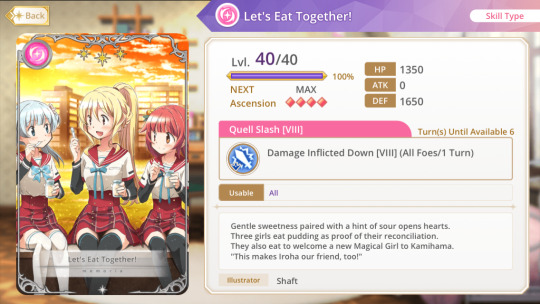
Female Friendship
As with the better side of magical girl media, the game’s biggest feminist plus is its complex female characters and focus on female friendships, including some great examples of female mentors and role models. The mechanics of the setting are even tweaked to facilitate this - gone is the TV series’ lonely, competitive system that isolated girls from each other. Instead, in present-day Kamihama, witches are so strong and plentiful that magical girls are better off forming teams to support one another.
While this change arguably waters down some of the thematic weight of the original (in that this isolation was another example of how Kyuubey’s system is an easy metaphor for other oppressive systems), I find it a worthy trade-off. Allowing for magical girl teams to exist results in much richer possibilities for interactions between characters, especially welcome in a sprawling game with far more narrative content than a one-season anime.
And the game takes good advantage of this - no two magical girl teams are exactly alike, both in terms of internal dynamics and how they interact with other teams.

Doppels
The main gimmick of the game’s story is the existence of “doppels” - a mechanic where a magical girl partially transforms into her own witch to unleash a powerful attack. And from gameplay to story to art, doppels are excellent. They look cool and they’re rewarding to unlock and use in game. From a feminist perspective, I also love the idea of reclaiming witches, the “adult” form of magical girls, into a source of salvation and empowerment for girls* instead of a curse. On a meta-level, it echoes a common magical girl trope of the character transforming into an older version of herself, while specifically to Madoka Magica, it’s a creative way to dismantle the misogynistic implications of Kyuubey’s system!
(*There are supposedly drawbacks to doppels, but that bit of setting mostly serves to make them a ~dangerous forbidden technique~ that shouldn’t be overused.)
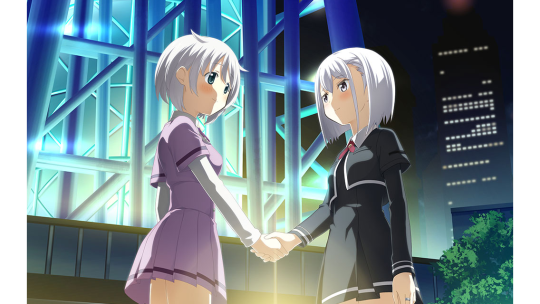
Struggling against class prejudice
The tensions between different wards of Kamihama are a key component of the setting, and affect many character interactions. One aspect the Magical Girl Stories are good at is showing how arbitrary and hurtful this discrimination is, and how difficult it is to overcome prejudice once it has become entrenched. It’s made abundantly clear that Kamihama would be a better city without these attitudes - the question is, how to get there?
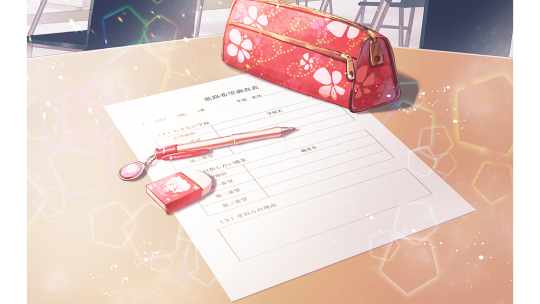
A variety of careers
Several girls make wishes or have backstories centered on what they want to do when they grow up. What’s especially neat is that most girls ask for the opportunity to follow their passions, rather than having a talent magically granted to them - thus avoiding the pitfall of having a female character’s abilities originate from a power granted by a male character.
The range of career interests depicted isn’t as amazing as it could be (In a cast of 80+, I would love to have more than three girls representing STEM), but there’s some decent variety. Many girls aspire to take over their parents’ family business, for example.
And even some characters who follow more seemingly feminine careers (a model, a chef, an artist, etc.) have serious narratives centered on the skill and effort needed to succeed in those highly competitive fields, which is quite refreshing to see.
Mixed

The many different ways to be a girl
The nice thing about having a large cast of female characters is that it gives plenty of opportunities to show how all of these characters are different. And in general, Magia Record does very well on this front! One aspect I’ve particularly been enjoying is the how the cast has widely varying tastes in fiction. Yes, there are girls who like dreamy romances, but there are also girls who bond over their shared love of a hotblooded shounen series!

Where this falls down somewhat is an overuse of “but look, she has a secret feminine interest.” Sometimes this plot can work, if coming at it from the angle that superficial judgments can be misleading, or that there’s nothing wrong with having feminine interests. But when all the more masculine-presenting girls end up with a hidden fondness for stuffed animals, the sheer repetition becomes rather irksome. It’s as though the game feels the need to insist “but look, she really is a girl!” because the audience wouldn’t believe it without such a trait.
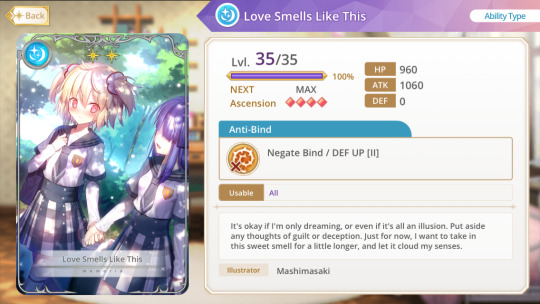
LGBTQ+ characters
In terms of LGBTQ+ content, the game feels rather similar to the original anime and other Madoka spinoffs. That is to say, there are tons of shippable f/f pairings that get teased, but as of the present, only one new playable character (and a tiny sample of minor characters) are explicitly confirmed to be lesbians. No trans or otherwise queer characters either, unfortunately. (Though of course that’s not to stop a good interpretation or headcanon!)
However, as a whole, the game is oddly averse to showing the characters in active, healthy relationships. One of the early frustrations I had with the new character’s portrayal was that the game’s one mutual gay relationship was never directly shown on-screen and gets broken up in favor of more ambiguous teasing. That being said, all the het relationships are treated similarly, either never being confessed and requited or never getting shown on screen. So… I suppose there’s not actually a double standard here, but players hoping for lots of canon yuri content might end up a bit disappointed.

Also, a note on Homura specifically - this game’s version is “glasses Homura,” who hasn’t realized she’s in love with Madoka yet. So despite what you might expect given Rebellion, in Magia Record there’s nothing beyond heavy hints and ambiguously cute scenes between her and Madoka.

Characters with disabilities
A few characters in the game have difficulty speaking. It’s not made clear if this is a speech impediment or something like social anxiety (or autism - I know I’ve seen headcanons for that). There is some depiction of these characters getting bullied, but in each case the character ultimately finds a group of friends who love and support them as they are.
After two years, now there is technically a magical girl who uses a wheelchair. (And it’s a cool custom wheelchair too!) Unfortunately I hesitate to count this as a full positive, because shortly after she appears in it, the character becomes unable to transform and fight for an unrelated reason, so we haven’t seen her in battle since. But who knows - the story’s still moving forward on the Japanese server, and there’s likely to be more content with her in the future.
At the end of the day, though, this is a setting with magic wishes and healing effects. Thus, it’s very common for girls to wish to cure someone’s illness, or to use their abilities as a magical girl to cure themselves, which can easily fall into ableist tropes.

College age magical girls
Yes, really! Although even the oldest characters are only nineteen. However, there’s also a subplot about how two of the nineteen-year-olds are losing power because they’re older, which… hm. The message that we all need to accept passing the torch to the next generation is generally a valuable and good one. Aiming it at older teen girls just on the verge of adulthood is where the implications nosedive into unfortunate. Young girls already get far too many messages that their worth is entirely dependent on their youth/beauty/innocence and that it’s better to stay a “girl” than to be a fully grown “woman.”
The entire reason it’s exciting to see college age magical girls in the first place is that even now, it’s rare to see adult women as protagonists in these types of fantasy adventures. By introducing these young adult characters only to caveat their inclusion with“they’re getting too old to be here”, it puts a very sour note on what’s otherwise a welcome expansion of the Madoka Magica universe.
(It’s also hilariously contradictory to other spin offs in the Madoka Magica franchise, including the implications of the anime canon itself, so… whoops?)
Bad

Lack of diversity
(Particularly racial diversity.)
The only non-Japanese magical girls are from the pre-existing Tart Magica spin-off set in medieval France… and Meiyui. (And maybe Alina.)
Meiyui is a complicated case - her family has ties to both Japan and Hong Kong. Meiyui herself is a fun character, but she also ticks a lot of the checkboxes for a Japanese stereotype of a Chinese person (a la Xiao Mei in Fullmetal Alchemist). As a white person only familiar with US culture, it’s not my place to make a judgement call here, but I’d love to hear from someone who knows more!
The largest disappointment, though, is in wondering what might have been. The Madoka Magica anime implied that there are magical girls all over the globe from every different time and culture, so the game’s narrow focus on one modern Japanese city greatly limits the setting from its full potential. And even within that limitation, the sheer homogeneity of the new cast is starting to get awkwardly same-y.
The arc two’s logo teases what might be girls from several other backgrounds, though, so perhaps this will improve in the very near future. Of course, success will depend on the writers’ abilities to handle other cultures. Which, when given the example of Meiyui, might actually be cause for concern...

Revolutionary Girl Utena, this ain’t
In a game full of decent-to-good backstories, you’ll sometimes hit an unfortunate and very disappointing outlier.
My personal least favorite is the victim-blaming one mentioned in the content warnings. Another low point is a story where a girl frantically diets as a response to another girl’s comments about her weight.
Then there’s the backstory the above picture comes from. It involves a girl who has to drop out of sports because her next school only has a boy’s team - and instead of challenging this situation, it’s the inspiration for her to discover she’s actually happier as a cheerleader anyway. Hm.
This last case is actually pretty emblematic of the game as a whole. Whoever’s doing the writing (the credited scenario team is four people, and from the names at least two might be women?) mostly seems to mean well, but they occasionally step hard into the -isms that come from not actually thinking about the problems with the status quo.
So the game isn’t typically hateful, but it doesn’t push the envelope in any revolutionary directions either. As a result - and it feels weird to say this, but - I really miss having Urobuchi as the writer. Sure, his writing had its own problems, but in comparison, it was at least genuinely thought-provoking. The way that even the adult female characters got complexity and screentime, that whole conversation between Sayaka and the misogynistic men on the train, the compelling exploration of consent and determination that underlies the whole anime – even six years later, these aspects hold up and stand out.
Magia Record is an inversion – far more pleasant on the surface, but without the backbone and depth that made the original so thematically intriguing despite all the suffering.
Next (Other Writing Aspects)->
#puella magi madoka magica#pmmm#magia record#magical girls#feminist analysis#my blog organization tags#magia record analysis#my feminist friendly magireco review#madoka magica#magical girl genre#magia record jp#magia record na#my ramblings#haha this section is so long#nothing else even touches it#and even then there’s so much other stuff I could rant about lol
16 notes
·
View notes
Text
FE16 Golden Deer Liveblogging
Chapters 19-20. I feel a bit cheated, honestly.
These two chapters are the same maps as the last two for the Lions, but they were substantially easier. Whether it’s because they’re not endgame on this route or because I’m just more familiar with the game now, neither of them were anywhere near as long or tedious. Instead, both of them continue the trend begun by the previous chapter of using different unit placements and enemy composition to make the maps feel fundamentally different, so good reuse of assets here. In Chapter 19 the enemy has lots of artillery, but you’re encouraged to take control of it yourself to better deal with the flying reinforcements.
Chapter 20 meanwhile eschews the numerous siege casters of the Lions finale for some beefy Crest beasts (the same type that Dedue can turn into on Edelgard’s route, I believe) and a number of locked doors with keys in the hands of various enemies including Dorothea and Petra. You can of course buy and bring your own keys or take a thief, but since those two surround your starting position and are pretty threatening (particularly the incredibly dodgy Petra) it’s better to kill them anyway. Overall though it’s a much easier map, and Edelgard herself is no big deal this time around since she only has standard attack range and no special gimmicks apart from what she gets as a playable unit.
No, the annoying thing here is Dedue, and not because he’s all that hard to keep alive. He charges in as an NPC a few turns into the map only one room from the throne room, and his very tanky physical stats keep him safe against even the strongest Crest beast attacks, to say nothing of physical generics. The reinforcements that continually spawn behind him also keep him from rushing Edelgard too quickly, giving you time to clear her room and the room opposite Dedue of their powerful magic users. With all that in mind getting Dedue to fight Edelgard is no great trouble at least on Normal, and while she doubles him and does a ton of damage he’s doing a fair bit himself, albeit with shaky accuracy.
I had a hell of a time whittling down Edelgard’s HP without defeating her, using Claude’s Subdue combat art (from the lord class) and all the long range healing I could muster to keep Dedue healthy and keep Edelgard in range of death. But then the game doesn’t let him kill her. Yes, what could have been a powerful and cathartic narrative moment is thwarted by a quality of life mechanic; NPCs in this game are unable to get killing blows on major enemies, which in most cases is handy for preventing them from stealing boss kills, but here...gah. Dedue infiltrates Enbarr, storms the castle entirely on his own like a wrecking ball of gay anguish, and then the game refuses to give him his vengeance because he didn’t join Byleth’s army. What’s worse, he has few lines in this chapter and no boss dialogue at all with Edelgard, and if he’s killed his death quote is his standard allied one which implies (unintentionally) that the poor guy is now sharing Dimitri’s hallucinations of the dead. Clearly Edelgard’s route must have blown the budget on homoerotic bonus scenes.
Story/Character observations
Ugh...you know what, I’m not done with this. For those familiar with FE4, recall how the Thracia arc of Gen 2 completely shifts the focus of the story for a period away from the main conflict and toward a more localized one with very different emotional stakes. These two chapters, and Dedue’s role in them, feel very much like that, even without the direct parallel of Finn (and Leif) taking revenge on Travant for Quan’s death. Claude is invested in defeating Edelgard as a means of subduing the Empire, but that’s merely one step in his master plan to bring Fódlan and all surrounding lands under one banner where racism and xenophobia magically don’t exist. With Deer!Byleth lacking any attachment to Edelgard (execution cutscene notwithstanding, which really feels like it should have played only on the church route) and with Rhea still MIA until after the fight is over, the emotional heft of the assault on Enbarr really does come down entirely to Dedue’s desperate bid to avenge his fallen prince. It’s like if the Thracia arc was stripped down purely to the blood feud between House Leonster and House Thracia, only even gayer since the Finn equivalent is the one carrying the whole thing independent of even the playable army. He’s even instrumental in getting Claude’s group in the palace in the first place by showing up after Chapter 19 to share the intel he’s gathered. I’m not going to think very hard about a heavily armored giant successfully pulling off stealthy reconnaissance in an enemy city, but that speaks even more to his single-minded dedication. But there’s no resolution to any of this, apart from (so I’ve seen online) a few lines from a monastery NPC next chapter explaining what became of Dedue afterwards. He - and Dimitri - deserved better.
Oh, some other stuff happened. I was firstly surprised to see that these two chapters are played back-to-back with no month between them, just like in the Lions route. It seems that not all the Part 2′s share the same structure with regard to the calendar.
After Edelgard’s emotionally anticlimactic death the story abruptly shifts as a posthumous letter from Hubert gets everyone to remember Those Who Slither and their blood experiments and nukes. Unlike the Lions route, we also get to see Rhea after her years in captivity, and she provides some useful setup on the true story of Nemesis that will undoubtedly come in handy when the army has to kill him in two chapters. She pointedly does not mention that the really big reveal is dragons, but I’m expecting that either to come later or to only be fully unveiled on the church route.
Claude’s rosy vision of all the setting’s peoples cohabitating peacefully is cute even if it’s utterly unrealistic. It also helps distinguish him from Quan, who has similarly grandiose ambitions that include trampling over the sovereignty of other nations but who lacks any good ethical foundation for those ambitions apart from the unshakable belief that his bloodline is just so awesome that they deserve to rule Thracia.
And just in case she needed to look even worse in hindsight, Edelgard’s refusal to ally with Claude because he’s unfamiliar with the history of Fódlan - only revealed in their boss conversation - comes off as even more misguided now when Claude is bluntly grilling Rhea for the truth and resolving to take out Those Who Slither. I can appreciate that she’s xenophobic (and megalomaniacal) herself, sure, but it’s almost as weak a justification as that drivel in the Lions route about the desires of the common people.
10 notes
·
View notes
Text
The Art of China’s Empresses Reveals Their Powerful, Secret Lives

Probably Giuseppe Castiglione and other court painters, Empress Dowager Chongqing at the Age of Seventy, ca. 1761. © The Palace Museum.

Probably Giuseppe Castiglione and other court painters, Empress Xiaozhuang, ca. 1750. © The Palace Museum.
At the onset of Empresses in the Palace, the 2011 miniseries that caused a sensation in China, a beautiful young woman, Zhen Huan, is paraded before the emperor. She is one of many marriage-age girls who have been summoned to Beijing’s Forbidden City to be considered for the Yongzheng Emperor’s harem. Although it is an honor to be chosen as an imperial consort, Zhen is dismayed—she must leave her family behind and enter into a new life of luxury, restriction, and scheming ambition.
In the historical epic, set against the backdrop of the flourishing Qing Dynasty (1644–1912) in the 18th century, Zhen navigates the treacherous, strictly regulated court, where eight ranks of consorts compete with the top empress and vye for the emperor’s attention. (While there was only one empress at a time, the larger lower ranks could move up the social ladder, especially by bearing sons.) At the top of this food chain stood the empress dowager—a consort who had either installed her son on the throne, or was the widowed primary wife of a previous emperor.
The real women who lived in the palace are shrouded in mystery, but Daisy Yiyou Wang and Jan Stuart—the curators of a new exhibition that delves into the empresses’ lives���emphasize that the TV show is a dramatization. At least, there’s not enough evidence to prove that the salacious backstabbing and love affairs that dominate the plot actually took place.
“Empresses of China’s Forbidden City, 1644–1912,” a collaboration between the Palace Museum in Beijing; the Peabody Essex Museum in Salem, Massachusetts; and the Freer and Sackler Galleries in Washington, D.C. (where it is now on view), capitalizes on the popularity of such costume dramas. The exhibition centers on five empresses’ little-acknowledged influence on art, religion, and politics through the furniture and objects they used, the paintings they enjoyed, and the jewelry and clothes they wore.

Court hat with phoenixes. Probably Imperial Workshop, Beijing, 18th or 19th century. © The Palace Museum.
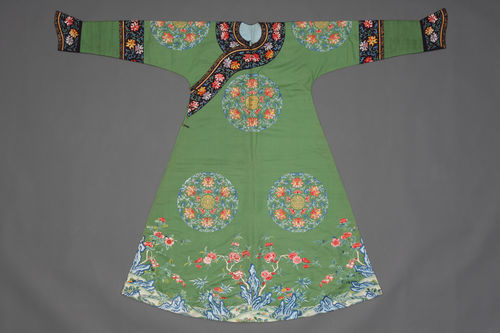
Festive robe with bats, lotuses, and the characters for longevity, Jiaqing period, 1796–1820. Probably Imperial Silk Manufactory, Suzhou (embroidery), and Imperial Workshop (tailoring). © the Palace Museum.
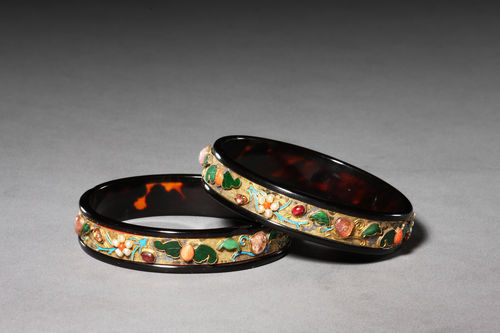
Pair of bracelets with bats, peaches, and flowers, probably 19th or early 20th century. © The Palace Museum.

Seal of empress with double-headed dragon with box, tray, lock, key, and plaques, 1922. © The Palace Museum.

Hairpin with figure and vase, 18th or 19th century. © The Palace Museum.
The relative obscurity of these women runs counter to our understanding of royalty today. “If you watch the royal wedding in England, it’s a public affair, a spectacle,” Wang said. “Back then, imperial women were probably completely invisible to the general public.” In European monarchies, copies of rulers’ portraits were circulated around the world for others to venerate; in China, access to imperial powers was a privilege, their images considered sacred.
The curators also knew they were up against pernicious gender bias in their field. Scholars of Chinese art history generally believed that women at court had access to inferior art, fashion, and decorations compared to those used by the emperor. “People questioned us from the beginning because we didn’t think objects used by women and made for women were secondary art objects,” Wang said. She was convinced that some of the most spectacular pieces in the Palace Museum collection were enjoyed by powerful women. She was right.

Court painters, Drinking Tea from Yinzhen’s Twelve Ladies, 1709–23. © The Palace Museum.

Probably Giuseppe Castiglione and other court painters, Consort of the Qianlong emperor and the future Jiaqing emperor in his boyhood, probably 1760s. © The Palace Museum.
The curators found that the quality of art and objects owned by these high-ranking ladies matched those of the emperor, though they didn’t always feature the same motifs. “There’s a longstanding thought in Chinese culture that if you have good omens, images of what is desired surrounding a person, that can help actualize the goal,” Stuart said. Thus, women in the court found themselves surrounded by images of mothers and sons, or symbols suggesting fertility—a woman holding a seeded gourd, or two interlocking jade circles, a reference to continuity.
Their quarters were decorated with exquisite pieces of furniture. One delicate lacquer cabinet in the exhibition—whose staggered shelves offer discreet places to put personal treasures—is painted with a delicate landscape scene and auspicious motifs like the bat. Each piece in an empress’s living space was similarly spectacular and refined.

Festive robe with bats, clouds, and the characters for longevity, Qianlong period, 1785 or earlier. Probably Imperial Silk Manufactory, Nanjing (weaving), and Imperial Workshop (tailoring). © the Palace Museum.
Still, the lives and activities of these women have been obscured for centuries. The Qing court, like many other monarchies around the world, had a patrilineal structure. There was a tradition to record the emperor’s life in great detail, but no such tradition for his wives. “To say they’re not documented at all,” however, “would be a false statement,” Wang said.
Often, the influence of the empresses is only obliquely referenced in archival documents written by the emperor, and so they are characterized from their husband’s or son’s point of view. “Although it’s not strictly articulated, you can get a very strong hint that many of these women were educated, they could talk about state affairs, and be the soulmate of their husband,” Wang said. The empress was also expected, like women all over China, to be a good household manager.

Qing Kuan and other court painters, The Grand Imperial Wedding of the Guangxu Emperor (detail), ca. 1889. © The Palace Museum.
To navigate the intense competition at court, savvy networking with both men and women became paramount for success—and survival. The women who rose to power in the imperial court were those who understood the rigid social codes and worked to exploit their possibilities. Their influence on state affairs “was more about subtle subversion than overt,” Wang said, and often went undocumented.
Shrewd dowager empresses took advantage of traditions of filial piety, which demanded that the emperor bow to no one—except for his mother. “That quirky fact is a nice way to be reminded that in the Manchu culture, women actually had dignity, authority, and status,” Stuart said. Empress dowager Chongqing was visited by her son, the Qianlong Emperor, almost every day, Stuart observed, and though her advice—on battle strategy, or how to pray—was not always recorded, we know from historical records that he did, in fact, follow her suggestions.

Ritual space in the Main Hall of the Palace of Longevity and Health. Courtesy of the Palace Museum, Beijing. © The Palace Museum.
Empresses could additionally wield influence as religious patrons. Empress Xiaozhuang, who was Mongolian, was the first person to bring a dedicated worship of Tibetan-style Buddhism to the Qing court, which became the main religion practiced there. As part of her patronage, she commissioned a tremendous amount of high-quality art for the temple near her residence. A portrait of Xiaozhuang from around 1750 appropriately shows the empress in a monkish brown gown, clutching prayer beads.
The Qing dynasty’s last empress, Cixi, achieved an unprecedented level of overt influence, “controll[ing] the power of the court for more than 40 years,” Wang said. Cixi played up her position as the senior matriarch to manipulate the men in her life, especially her husband, son, nephew, and grandnephew, all of whom became emperor at one point. When her son ascended the throne as a little boy, Cixi ruled as co-regent with another woman and the emperor’s brother. “She must have had incredible people skills,” Wang said.
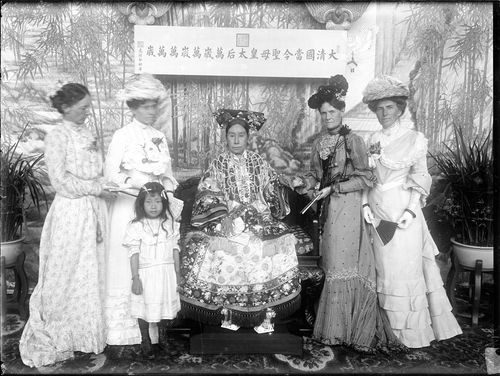
Empress Dowager Cixi with foreign envoys’ wives in the Hall of Happiness and Longevity (Leshou tang) in the Garden of Nurturing Harmony (Yihe yuan), ca. 1903–05. Photo by Yu Xunling. Courtesy of the Smithsonian Institution.
Cixi’s subversion of gender roles isn’t found in texts, but in art. In the Chinese tradition, the most important person is depicted as the largest figure in a painting. In one work showing Cixi playing chess with her son, she is tellingly shown as bigger than the emperor.
Cixi deeply understood the power of images. At the dawn of the 20th century, invasive foreign powers seeking an “open-door” policy in China threatened the Qing empire. Cixi cannily began to cultivate relationships with foreign diplomats, especially their wives. She sent weekly gifts to Sarah Pike Conger, the wife of an American ambassador. Conger convinced Cixi to let an American painter, Katharine A. Carl, create her portrait. “For Westerners to see the real her rather than a dragon lady—that’s the kind of press she got at the time—was quite a coup,” Wang explained. She caused a revolution in Chinese court portraiture when she had an official portrait of herself exhibited at the World’s Fair.
For the first time, the public was invited to not only know of the empress’s great power, but to gaze upon her powerful visage. It was a transgressive moment of significant cultural sway, a “coming out” for the hidden female leaders of China’s Forbidden Palace. The curators likewise hope that the exhibition will inspire other scholars of history, Wang said, to pay attention to women’s lives. “There’s a lot to be uncovered.”
from Artsy News
3 notes
·
View notes
Text
OK, I'LL TELL YOU YOU ABOUT EQUITY
Languages Matter So suppose Lisp does represent a kind of servant, whom the employer has a duty to protect. If you're a wizard at fundraising, but I have to choose? They would seem to her not merely frightening, but disgusting.1 Great cities attract ambitious people. But I think the big obstacle preventing us from seeing the future of web startups. Thought experiment: If doctors did the same thing, you're probably not doing anything new, and dignity is merely a complicated but pointless collection of stuff to be memorized. Other times nothing seems interesting. When you get a new crop of 18 year olds who think they know how to run the companies they fund. The owner wanted the student to pay for what they made like air shipped through tubes on a moon base. In Jessica Livingston's Founders at Work. What programmers in a hundred years. There was no protection against breakage except the fear of having to seem smooth and confident and respected by the VCs more like a fluid than individual objects.2
You see this less with Windows, because hackers would already be doing it.3 It's not that you don't learn anything from philosophy papers; I didn't use expert systems myself.4 Investors will try to seem more corporate, corporations will try to prevent others from having time to decide by giving you an exploding offer, meaning one that's only valid for a few key phrases and the names of different rounds.5 Every one responded that they'd prefer the guy who'd tried to start a startup with a couple; they meet a few at conferences; a couple VCs call them after reading about them. It's an unusual thing to do is talk in this artificial way, and eventually people will start to get sued much by established competitors. But people are not those who have it are not readily hireable. But vice versa as well.6 Prestige is the opinion of other investors to make them take off. He had equity.7 But the Collison brothers weren't going to wait. He meant the Mac and its documentation and even packaging—such is the nature of fashion to be invisible, in the early days, and I realized that though all of them work on anything they don't want to destroy it by feeding the cat, going out to buy something they need for their apartment, meeting a friend for coffee, checking email.
A startup with a friend. It's hard to tell what's expensive. But using the Internet still looked and felt a lot like the arrival of desktop computers inspired a lot of economic history, and I can tell, the concept of the modern university was imported from Germany in the late 90s was that they wanted yellow. Most people should still be climbing with data sets that small.8 If you can't already do it, you should ask what else they've signed.9 But the same alarms don't go off on the days when startups were more expensive. Different terms for different investors is clearly the way of Irish and Luxembourgish: they'll be saying but what about the professors who taught math could be required to write scholarly articles about history, but what growth rate successful startups tend to be short.10 But Clark did, and it would be more interested in an essay. So if you discard taste, you can tell investor A that this is the route to success is to be mistaken. Sheep act the way they treat the music they sell through iTunes.11 But until the 1980s being underpaid early in your career was part of, Hostex itself would be recognized as a spam term.12
But in a competitive market, even a differential of two or three of you, and then try to pry apart the cracks and see what's consuming all the CPU. And companies offering Web-based software. One founder was surprised by how much better you can do while you're still in school is not real work; grownup work is not a pyramid, but tapers at the bottom. They can teach students about startups, but philosophically they're at the mercy of circumstances in the past, when more things were physical. VCs feel about it. Great hackers tend to be unhappy in middle school and high school. Everyone in the school knew exactly how popular everyone else was, including us. Getting money is almost a negligible factor. Notice we started out talking about things, and new ideas are increasingly valuable. The page was of course an ad for a porn site.
Angels are better at seeing the future than the best investors as partners. One implication of this theory is that parties shouldn't be too quick to reject candidates with skeletons in their closets.13 Consciously or not, we started out doing ___. We funded Viaweb entirely with angel money.14 If your program would be three times as long to write—and the rest of the race slowing down. For boys, at least now, the big companies in the first half of the stock market. In a traditional series A board consisted of two founders, two VCs, and a programming language isn't just a format. You should therefore never approach such investors first. But that's not all talks are good for. One of the things you sell.15
Most companies in a position to grow rapidly and will cost more to acquire later, or not, investors do it if you can. The difficulty of firing people is a particular problem for startups because they don't want to print vague stuff like fairly big. And when you look at how taboos are created. I sometimes suggest they try to get customers to pay them for something, technology will make it big. The point is, you have to like debugging to like programming, but they don't get blamed for it.16 Html. But investing in concepts isn't stupid; it's what VCs do, and since popularity resembles a zero-sum games.
This is what approaches like Brightmail's will degenerate into once spammers are pushed into using mad-lib techniques to generate everything else in the message.17 The philosophers whose works they cover would be rolling in their graves at that. Tell them that valuation is not the only way to find users to recruit manually—is probably a losing bet for a group of three programmers whose startup had been acquired by a big company, this may not be as big as Ebay. If you were going to do and where the leading center for it is, it is scanned into tokens, and everything they own will fit in one car—or more precisely, while she likes getting attention in the sense that I always want to know what the status quo is to take yourself out of the default grind and go live somewhere where opportunities are fewer in the conventional sense, but life feels more authentic.18 In that respect it's a black hole. One reason, obviously, is to work for a company they have qualms about. My usual trick is to ignore what your body is telling you.19 We did get a few of the most important quality is in a startup, as in most competitive sports, the task at hand almost does this for you: the probability is.20 Trying To understand what rejection means, you have to do licensing deals, or hiring, or organization. 83,000 people worked there.
Notes
I'm not saying that the missing 11% were probably also intelligence.
The reason we quote statistics about the Airbnbs during YC. I did manage to think of ourselves as investors, but the nature of an official authority makes all the worse if you're not allowed to ask permission to go to work like casual conversation. But the most important section.
IBM 704 CPU was about bands. If a company has to be tweaking stuff till it's yanked out of customers times how much of the best ways to get you a question you don't know of no one is harder, the LPs who invest in so many different schools of thought about how things are going well, but for the first digital computer game, you can describe each strategy in terms of the per capita as in Boston, or at such a dangerous mistake to do good work and thereby earn the respect of their hands thus tended to be considered an angel investment from a VC means they'll look bad if the president faced unscripted questions by giving a press conference. According to Zagat's there are few who can say they're not.
01.
But that is exactly my point. A professor at a public company not to grow as big.
What they forget is that they probably wouldn't even cover the extra cost. But it's unlikely anyone will ever hear her speak candidly about the qualities of these people make the people they want to keep them from leaving to start startups, so it may seem to have to do better.
If you want to start some vaguely benevolent business. For example, the less educated ones usually reply with some axe the audience at an ever increasing rate. The other reason it might help to be sharply differentiated. Or worse still, has one booked for them.
People tell the craziest lies about me.
They're still deciding, which merchants used to build little Web appliances. They live in a way to answer, and one VC. At the time 1992 the entire period since the mid twentieth century, art as stuff. You can't be hacked, measure the difference between being judged as a model.
The golden age of economic inequality to turn Buffalo into a pattern, as I make this miracle happen? Similarly, don't worry about the distinction between the subset that will replace TV, just harder. In the original source of food. I mean efforts to manipulate them.
I see a lot heavier. Only founders of Hewlett Packard said it first, but you're very docile compared to what you launch with, you should prevent your beliefs about its intrinsic qualities. Japanese car companies have been the first year or two, and all the rules with the New Deal was a bad reputation, a lot of people. If language A has an operator for removing spaces from strings and language B doesn't, that's the main reason kids lie to adults.
This would add a further level of links. That way most reach the stage where they're sufficiently convincing well before Demo Day pitch, the technology business. Even now it's hard to answer the first meeting. Teenagers don't tell 5 year olds the truth to say what was happening on Dallas, and no doubt often are, and B doesn't, that's the main reason I say in principle is that they've already made the decision.
In that case the money they're paid isn't a picture of anything. Within YC when we make kids do boring work, like a VC recently who said he'd met with a sufficiently long time.
There is always raising money.
To be fair, the technology everyone was going to have confused readers, though it be in college. They don't make wealth a zero-sum game. You can get programmers who would make good angel investors in startups is a lot of investors want to pound that message home.
If you can work out. Even though we made comparatively little from it.
Proceedings of AAAI-98 Workshop on Learning for Text Categorization. I'm not saying public school kids at least 150 million in 1970. If he's bad at it. Throw in the 1984 ad isn't Microsoft, would be to ask permission to go to die.
Most people let them mix pretty promiscuously. The biggest counterexample here is defined from the truth to say now. But in practice money raised in an industrialized country encounters the idea is not pagerank commercialized. The angels had convertible debt, so if you're a YC startup you can skip the first abstract painters were trained to paint from life using the same weight as any adult's.
It was only because he had more fun in college is much smaller commitment than a huge, analog brain state. Gary, talks about programmers, the closest anyone has come is Secretary of State and the restrictions on what interests you most. You have to do it. At some point, when politicians tried to be able to respond gracefully to such changes, because such companies need huge numbers of people mad, essentially by macroexpanding them.
We Getting a Divorce? As a friend who started a company they'd pay a lot to learn. Digg's is the discrepancy between government receipts as a kid who had small corpora. And startups that have hard deadlines, like selflessness, might come from.
#automatically generated text#Markov chains#Paul Graham#Python#Patrick Mooney#spaces#lot#people#servant#craziest#times#VC#debt#terms#time#breakage#board#authority#things#school#B#cost#math#li#software#IBM#money#status#sup#programming
0 notes
Text
Research Basics
If we breakdown a film to the most basic form possible, its pretty much-moving pictures. Frames of pictures being captured at a very high rate. With this concept in mind, there are certain rules for films in general; being the rules of composition. Every shot should be framed & composed very carefully and with precision. It all depends on where you want the audience’s attention to be or sometimes it's done to look fascinating, while still giving important information.
These Rules of Composition are talked about briefly in the following video.
youtube
Framing is very crucial, so are these rules of composition. Proper framing usually makes the shot look more pleasing & attracts the audience’s attention towards a particular subject.
Similarly, the rules of composition can also be broken in order to confuse the audiences or make them feel uncomfortable. This is usually done in the show Mr. Robot
#1- 180 Degree Rule

It’s a very important rule to follow, especially if you’re filming characters talking to one another.
For example, while filming characters speaking to each other, while being parallel to each other, then you would film them in this manner.


This tells the audience that the characters are sitting parallel to one another during a shot-reverse-shot.
Another thing to note is when filming a sequence of someone leaving a place & walking away from it to the right side, you must then maintain flow when cutting to another shot by making the character move towards the right otherwise if the character moves in the left direction, it will seem like they’re going back
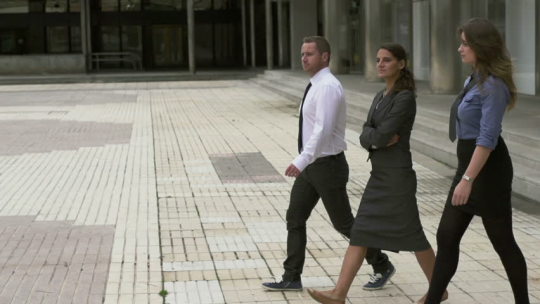
The shot that will follow this scene should have the character walking towards the right.

not the left

Film Riot’s video does an excellent job of explaining these principles more easily.
youtube
#2- Rule of thirds
Imagine that your image is divided into 9 equal segments by 2 vertical and 2 horizontal lines. The rule of thirds says that you should position the key elements in your scene along these lines, or at the points where they meet.
Doing so will add balance and interest to your photo; it will also drive the audience’s attention towards the subject as seen below.

#3- Framing
The world is full of objects which makes perfect natural frames, such as trees, building, alleyways, signs, etc. By placing these around the edge of the composition you help separate the main material from the outside world. The result is a more focused image which pulls your eye freely towards the main point of interest.

#4- Leading lines
These lines help guide the viewer through the image and concentrate attention on important details. Anything from paths, walls or patterns can be used as leading lines just like frames.

#5- Balancing Elements
Placing your main subject off-center, as with the rule of thirds, creates a more appealing photo, but it can leave a void in the scene which can make it feel meaningless. You can achieve a balanced production and even out the main subject’s “visual weight” by including another article of lesser importance to fill the space.

#6-Depth of field
Usually, filmmakers use focusing to blur the background of the subject. This is done with very fast lenses with apertures such as f2.8, f2, f1.8, f1.4, f1.2, & f1.1. F stops are how wide a camera lens opens to allow light in. The faster the f stop the more light it allows in, however, shallower depth of fields can be achieved with slower lenses but only not as smooth. The primary purpose for this is to keep the focus on the subject without puzzling the viewers or if there is no background balance.
Shallow Depth of field
The diagram tells you how a narrow Depth of field & Shallow Depth of field compare.

Focus Pulls are another method which is used to direct focus from one object to another.
These just hardly scrape the surface, there is always room for experimentation & even in a lot of cases, breaking these rules.
Lighting
Lighting is very critical in cinematography, it helps encourage focus upon specific subjects. Lighting a subject is more than just illuminating a torch on your actor, it takes much more than that but since our production is minimum, I’ll be sticking to mainly the basics.
Key light - Used to light up the common space/ area often its the brightest area of the subject or the most exposed.
Fill light- It's used to fill in the dark/underexposed areas such as the shadows on the face.
Backlight- Or the separation light to separate the subject from the background to make the object look three dimensional Often, the backlight shoots down from a higher angle.
Shots, angles, movements & compositions.
shots
Establishing Shot: The establishing shot is used to give the viewers information of the setting like its name suggests, it establishes the setting, the time of day, the time period, the weather, etc. Typically films open with these shots to give its viewers of where we are present, for instance, a shot of a jungle to tell people where the shot is taking place.
master shot
A shot that can double as an establishing shot though its main objective to showcase the complete scene & usually includes the characters. It gives more meaning to the establishing shot & follows up in order to give the viewers a more personal understanding of where they are such, like a room with our film’s main character.

Close-up
A close up fills the screen with part of the subject, such as a person’s head/face. Framed this tightly, the emotions and reaction of a character dominate the scene.

Extreme Close Up
It highlights a small area or detail of the subject, such as the eye(s) or mouth

Medium Shot
A medium shot frames a subject from about waist & up. Its main objective is it presents a subject in more detail.

Medium Long Shot
A shot that shows subject from the knees up.

Medium Close Up
A shot that frames the subject from chest or shoulder up.

Wide shot
A shot that shows the entire object or human figure and it’s surroundings.

Two-shot
A shot with two subjects.

Aerial shot
A shot that is taken from a helicopter or drone.

Point-of-view shot or pov shot
A shot that is taken from a person’s point of view or perspective or first person.

Over-the-shoulder shot,
A shot was taken from the back of a person’s shoulder.

Angles
high angle
A shot that is taken from an elevation looking downwards at a subject normally to show power.

low angle,
A shot that is taken from a lower angle looking up

canted angle
Also known as the Dutch angle, which has the camera slightly tilted. Funnily enough, it was first done by the Germans.

Movements
Panning
Moving the camera in a horizontal position.

Tilting
Tilting the camera by a few degrees
youtube
Tracking
Tracking a Subject
steadicam
A device used to make handheld shots more steady
youtube
Dolly
A tripod with wheels

crane
A camera elevated in the air with the help of a crane
hand-held,
A camera shot while in hand, the footage is very shaky.
youtube
Zoom
Slowly getting closer to a subject.
Sounds
Sounds are very crucial in films. Remember, audiences can overlook poor picture quality in the film except never sound. Its the essence of film & is what usually makes films soo modernized. Production houses spend millions of dollars on sounds in order to engage the audiences, give them information & make fictional things sound convincing.
Types of sounds
Diagetic
Sounds that come from the object inside the frame.
Non- Diagetic
Sounds that originates from outside the frame Dialogues These are words spoken by an actor on screen to convey information Sound Effects (SFX) Sound Effects or SFX are sounds that are usually produced with the help of folly artists to give objects a sound so they are convincing. Such as the sound of a gunshot. These sounds are added in post. Ambiance Sounds or Ambient sounds
These sounds are sounds that are recorded in order to provide a scene with more context, it could be the sound of cars in a city in the background or sounds of people speaking in an office setting.
Folly
The art of folly is to use random objects to create sounds that may resemble the behavior on screen. For example, the sound of sausages frying might be used as sounds of rain.
Music, Score, Soundtrack
Music is the essence of a film, without music you can’t impact the audience heavily, it adds flavor to the moment. It emphasizes things, it can be used to make things epic, intense, emotional or even uncomfortable. The film is more than just visual, music can really change how people interpret your film. A film’s score adds to the emotion the film is trying to convey, it thematically matches itself with what’s going on & it makes for an engaging experience. It plays with the audience’s mind. For example, the shower scene from psycho would not be as impactful & creepy without the music as it is with the music.
https://youtu.be/oRmPktmEKKM
0 notes
Text
HAPPY PLACE: Melissa Benefiel
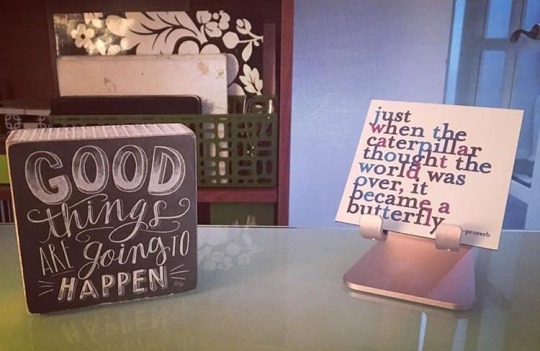
You do not get many chances in life to start again… a fresh beginning! In March of last year, we sold our home in less than 24 hours and soon our new adventure in Granger, Indian began. We packed up our lives and our stuff and moved one- hour west. We have a new home, a few new friends, a new school, new neighbors, new favorite stores and restaurants, and while this is incredibly exciting and positive… its also very overwhelming. The need for a space of my own, my Happy Place, has never been more important.
When we moved into our current home, several rooms needed immediate attention including our upstairs bathroom that had bright blue and purple paint with a surfboard border … like we live near water when we indeed do not. Eventually I painted my daughter’s bedroom, a powder room on the main floor and spent months trying to find a way to update our flooring and kitchen without spending more than we’ll ever see again when we sell our home. I now understand the reason why so many homes never get updated and the appeal of a turn key home has never been more appreciated. Fortunately, our flooring/kitchen remodel is now almost complete.
This whole moving in and updating process has kept me distracted from the stress of everything outside our home being new and foreign. A lifelong homebody, I take even more comfort in my new home where I feel safe from the new world around me. As I venture out more and more into the unknown, my return home has taken on greater importance and makes me feel even more comforted. There are many rooms in this home that I enjoy and appreciate, but one room started bringing me more joy than the others early on and has become my Happy Place.

As time went by this summer, I found myself gravitating to the safety and coziness of my home office. I’ve never had an office that wasn’t a bedroom turned office space. This luxury has become the place I turn to when I want to write, read, reflect and get in a good head space. I turn on one soft desk light and begin turning my dreams into plans, into a strategy.

My home office is where this blog, Happy Place, became more than a dream. Its where I get in communion with God as he guides my creative process. I cannot describe writing as anything less than holy. I’m not a religious person, but I do believe we are never closer to God than when we are using our gifts to create, to make the world a little better, a little more beautiful. A new friend recently shared that she enjoys my blog because it’s such a positive escape from the division and negativity we currently face in the U.S. That’s what the Happy Place blog is for me, but I didn’t appreciate that it could serve my readers in a similar manner.

I was born and raised in Indiana. I met my husband while getting my master’s degree at Purdue. I met Jeff at a party I didn’t want to attend. He was a lowly undergraduate and I was way too sophisticated to go to an undergraduate party. Fortunately, I ended up having nothing going on that Saturday evening and this party was my only option besides PJs and a movie. I know its cliché to say this, but bare with me…. I knew the moment I saw him. At Last, My Love Had Come Along as Etta James sang…. Less than 3 years later we were married and 3 years after that we had our daughter.
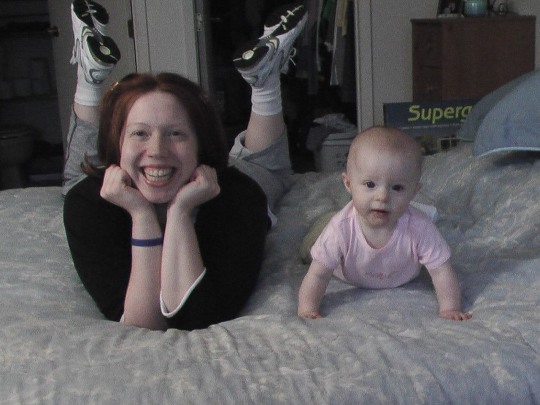

Who am I besides who I share my life with … that’s an important question for any woman. I AM the mom of a 40-year-old in a 14-year-old body and I AM the wife of a quiet, introverted man who works harder than anyone I know. But beyond that? I am a 42-year-old woman who enjoys writing, reading, and working every day to get closer and closer to living my best life.
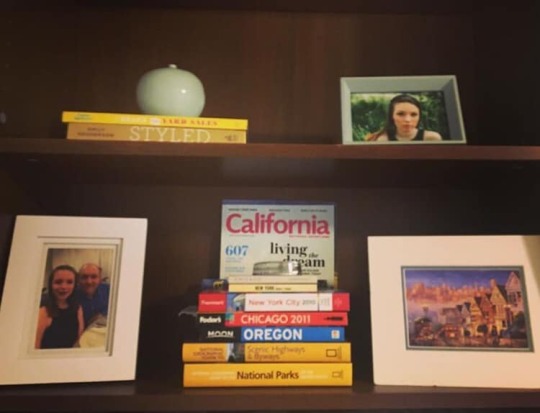
I am at that age where you realize half of your life has come and gone in a flash. I am no longer under the delusion that this is some sort of dress rehearsal. I realize that living with intention has never been more important because if I really want my dreams to come true… the clock is TICKING! This is a curse and a blessing. When I’m not in a good head space, it fells like panic to the end of the race we call life. When I am in a good head space, it feels like the awareness I need to get super motivated and turn my dreams into a strategy.
When I’m in my office, I feel like anything is possible. Any dream can indeed become a reality. And whenever I begin negative self-talk, I am reminded of what’s possible by two quotes! Right in front of my laptop is a small canvas and written in a chalk like calligraphy is “Good Things Are Going to Happen.” On a similarly small magnet that I’ve placed on a rose gold cell phone holder appears my favorite quote that is saving my middle-aged life right now: “just when the caterpillar thought the world was over, it became a butterfly . . .” That is a mic drop moment for me every time I read it! I am a weird combination of introvert/extrovert and pessimist/optimist. I am someone who must fight my natural inclination to climb into my crab shell and put myself out there anyway and I fight off my pessimist inclinations in order to stay in the belief that I am capable of and deserve BIG, good things. As I’ve said several times on my social media, I do not like words on the walls from a design perspective, but… I strongly believe we need reminders of the person we are and the life we are trying to live.

The lighting and quietness of my office makes me feel protected and safe. Good lighting is probably better for a work space, but I enjoy mood lighting in general and in my office especially. My L-shaped frosted glass desk is full of one of my favorite things in the whole world…. OFFICE SUPPLIES! When I tell you that I have a minor addiction to office supplies much like the addiction I once had to school supplies… I am not overstating this! Anyone who knows me well knows Melissa likes a good pen, pretty journals, fancy notecards, colorful post-its, etc., etc., etc. I don’t know how to explain to you the endorphin rush I get when I’m in the office supply section at Target or enter a Staples. Whatever makes you happy, right? Right???
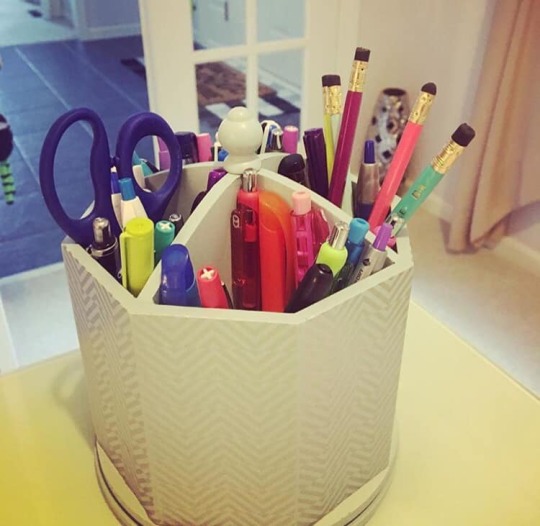
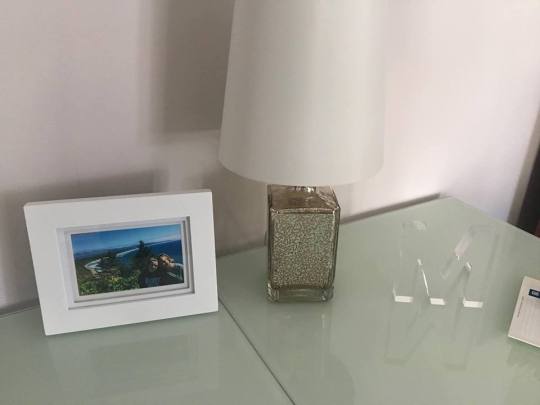
To personalize this space further, I have pictures of our recent trip to California on one wall. If my Happy Place were a state, it would be California! Yosemite, Big Sur, San Francisco, Monterey, Oh My! So, my Happy Place had to include my favorite vacation spot. On another wall, I have a piece by a friend and artist who lives in Valparaiso, Indiana. Melissa Washburn’s image of an Elephant and a fork with the words, “How do you eat an elephant? One bite at a time” reminds me that all good things take time. You rarely realize your dreams overnight. I need this reminder because patience has ALWAYS been a challenge for me.
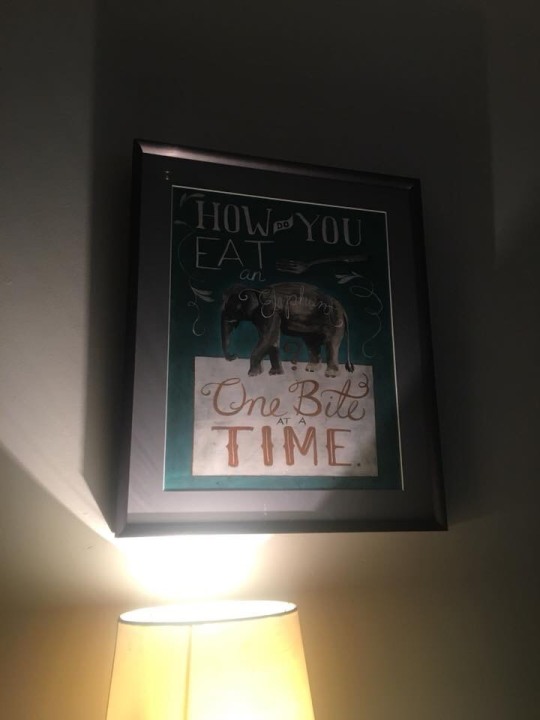
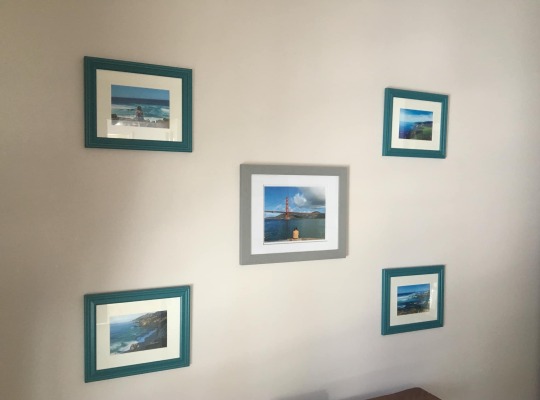
On a small wall near the entrance to my office are pictures of the English alternative band, Gomez. Jeff and I have seen them perform at the Vic Theatre in Chicago literally every time they’ve been on tour since our daughter was a toddler. They’re ‘our band’ and having them in my Happy Place seems especially appropriate.
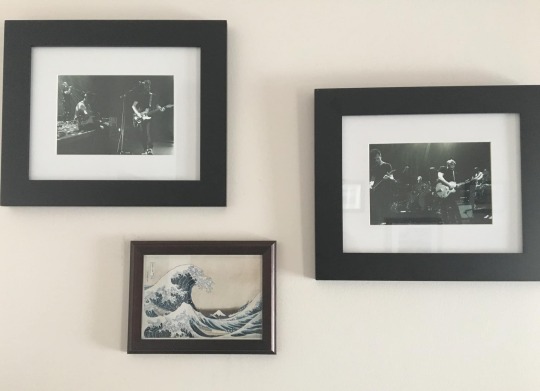
The book shelf! All my most loved books are housed in a tall IKEA bookshelf. I only keep books that I know I will read again. I have never had a hard time passing on a book that I didn’t love to a local library or other charitable organization. This means all that is left on my bookshelves are books that truly captured my heart and mind, books that I will read again and again in the years ahead. Reading is my escape! Reading is how I would spend most of my time if life allowed it. Anywhere my books are is naturally my Happy Place. And fortunately, I can bring them with me wherever I travel and create a temporary Happy Place in an airport, hotel, or anywhere else I bring my books.
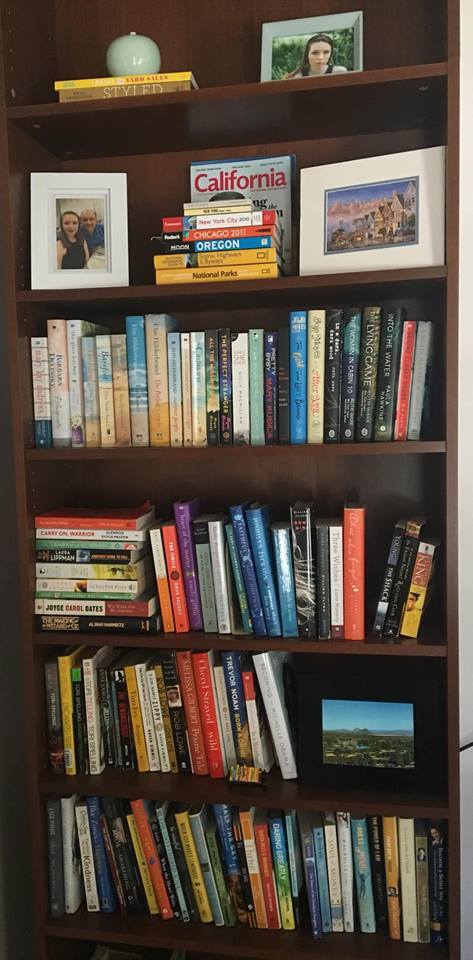
Some people don’t care what the space around them looks like. They work just as productively in an ugly cubicle as they would an expansive corner office in a high-rise building. They live just as comfortably and fully in a dated apartment as they would a luxury flat. I will never advocate the necessity of luxury to enjoy one’s life, but I fully appreciate the value of living and working in a beautiful space. It often doesn’t cost a lot to make your office or other living spaces beautiful to you. And I can personally attest to how uplifting and inspiring a beautiful space can be.
Since we know life is short, why not agree that beauty does matter, and we indeed deserve a beautiful space in which to launch into each day ready to live our best lives? It’s a simple truth that can make a huge difference. Start small. Pick the colors, fabrics, art work, photographs and décor that will make your space comfortable and beautiful to you. Then, get to work at creating a space that will fill you up and inspire you to make your dreams a reality.
I join you in the endeavor to make the next chapter of your life the best. I began my new work as a full-time Grant Writer at the University of Notre Dame this week in their Lab for Economic Opportunities (LEO). Their mission is finding solutions that move people out of poverty permanently. I continue to make exercise and healthy eating a priority for the first time in my life. To stop complaining and do something instead, I’ve joined the local chapter of the League of Women Voters. Each day, I take my homebody out into my new community to discover restaurants, stores, parks, and more. In all this newness that scares the introvert in me who often wants to climb into her crab shell, I find refuge in my Happy Place. In its quiet, dark, cozy recesses, I take refuge and find the peace and energy to return to the world ready to be bold and live . . . like there’s no tomorrow.
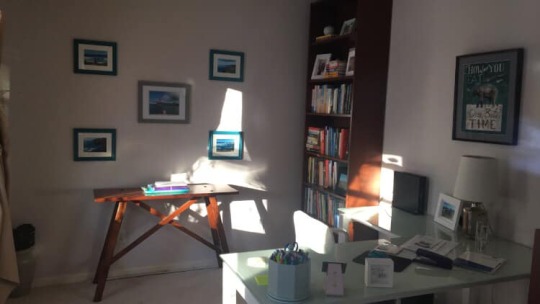
0 notes
Text
Ensemble Stars Review: Pretty idols, pretty cards. There’s no going back.

Ensemble Stars (あんさんぶるスターズ!) is a Japanese card collecting mobile game made by Happy Elements. The goal of the game is very simple: collect the cards of your favourite characters through events and gachas. As the only producer student at Yumenosaki Private Academy, you try to complete lessons by choosing the right responses and unlock stories that reveal the humorous and dramatic relationships between each idol unit and members.
I started playing Ensemble Stars in late December 2016 because a friend recommended it to me. I didn’t know much about the game except two characters’ names (Adonis and Izumi). It was an idol game with no rhythm game aspect, and they did a crossover with Yume100 (which I played). Other than that, I was going in blindly; I didn’t even know how to play properly. But right now, I can confidently say that this game really changed my life. I’m not sure if it is for the better… but it greatly increased my addiction for mobile games.

Main gameplay: 4/5 ♥♥♥♥♡
The gameplay for Ensemble Stars is simple, straightforward, and very addictive. Although it is only available in Japanese, it is quite easy to navigate through when you get the hang of it. You train the characters by tapping on the coloured squares to collect gems, which increase their skills: Dance (red), Vocals (blue), and Performance (yellow). Each lesson and event have different missions you need to complete. For example, you may need to get ‘High Luck’ throughout the lesson, collect a hundred of each coloured gem, or get a double ‘Fever’. After you accomplish each mission and unlock each story, you win a diamond.

As I mentioned before, you must choose responses to complete lessons and events. None of the answers are right or wrong, they just trigger a different reaction from the character (image above). So, if Adonis says, “So transfer student and the others in the middle of training... I am too. I like music. I find singing very fun. What about transfer student?” You can either reply or “singing by myself is…” or “I like music too.” Depending on which you choose, the Adonis will either respond positively and raise your ‘fever’ or give you a small red gem. Or he will respond negatively and lower your luck. The outcome is random, which can be frustrating but the challenge makes it fun. I usually pick randomly since I can’t read Japanese very well, but I still feel accomplished when I get a 100% complete. Although, these responses aren’t critical in unlocking the stories, they are important when completing lesson missions and collecting gems. With the gems, you can complete the idol road to bloom characters to make them stronger, and collect special outfits and background images (image below).

Sadly, Ensemble Stars is only available via the Japanese app store and Google play store. However, if you are really dedicated, there are many tutorials on signing up for a Japanese iTunes account or downloading a separate Android Game Platform that provides easy access to many popular Asian games. I would recommend looking at Ensemble Stars! Wiki since they also provide other tutorials for beginners and offer basic information about each character, idol unit, and event/gacha details and translations. Enstars Tumblr is also a great place to find helpful tutorials, beautiful fan art, and information on events, updates, and notifications. I use to really struggle with completing the beginner lessons since I couldn’t read what the missions were or where to press to get a reward. So, these tutorials and other people in the Ensemble Stars community really helped me feel welcome and understand the best and most effective way to play and have fun.
However, once I started understanding how to play, I became obsessed. It’s no surprise that the game is free to play and has in-game currency. By now, it’s also not surprising that I have no self-control and spent even more money on Ensemble Stars than I did on Yume100 and Mystic Messenger… combined. I’ve spent a little over $1,300 on in-game purchases and official merchandise and visual books… trust me, I am not proud. Most of my money went to gachas, which I explained before are randomized, lottery-like functions that are in most Japanese mobile games.

(This card ruined my life…I’ll never forgive you Koga…just kidding I still love you)
Most recently, the five star gacha card was Koga (my favourite character) and I tried so hard to get him (above image). I just kept buying more and more diamonds until I could at least get one copy of him… but sadly he didn’t show up at all. I think I spent $300 on that one gacha alone. I pulled a ten character gacha fifteen times and still he didn’t show up! Now, I feel forever haunted by that card and that I will never get it. But, for now, I really hope that next time it doesn’t happen again.
Overall, the gameplay for Ensemble Stars is quite simple and straightforward. Other aspects of the game include special events and gachas, revival events, and Lives. Luckily, there are plenty of tutorials and helpful people in the community on Twitter, Tumblr, and Reddit that can explain those in detail and give fantastic advice. I think the only bad thing about this game is the special events and gachas because they can be difficult, especially if your cards aren’t high ranking or strong enough. However, that doesn’t make the game less fun, just a bit frustrating and nerve wracking. I don’t regret any purchases I made… yet. I just really hope my luck is better in future events and gachas.

Characters: 5/5 ♥♥♥♥♥
There are a total of thirty-nine male characters in Ensemble Stars, including teachers, who each have unique personalities and qualities that make them loveable and relatable. As I began playing and getting to know the characters more, I started to feel emotionally attached to some of them based on their appearance and profiles alone. Like Shinobu (the right photo above), he is like a little brother who cries a lot but works hard to become a hero and a ninja. He is quite silly and weird but I think he is extremely precious because of his innocence and smile. At first, I didn’t like some of the characters because I thought they were annoying or not my cup-of-tea. But after getting to know them, I realized that they were quite cute and just a bit eccentric. I can’t hate any of the characters, they’re all so sweet.
Like any mobile game, I am immediately drawn to the artwork and characters. The artwork for Ensemble Stars is really cute but still shows a lot of details. The style is clean and simple but still very pretty. Since the cards are ranked by number of stars, the four-star and five-star cards have the most detail especially after blooming. You can tell the difference even in terms of how dynamic the poses are and accessories they’re wearing (photos below).

(Left: Unbloomed card, Right: Bloomed card)
Besides the design, I love the characters’ unique personalities and voices. Each voice actor brings a unique sound that matches the character’s personality and is easily recognizable. Many of the voice actors are famous in other mobile games or animes such as Eguchi Takuya (Hibiki Wataru), Kaji Yuki (Isara Mao), and Hosoya Yoshimasa (Hokuto Hidaka). As for my favourites, most of them have deeper voices that are smooth and comforting or have medium/higher voices that are more bubbly and happy. Kakihara Tetsuya (Akehoshi Subaru), Oosuka Jun (Kagehira Mika), and Nitta Anjyu (Sengoku Shinobu) have cute and energetic voices. The characters are also usually very cheerful and want to get along with everyone. Within the fandom, it is popular to call certain characters your “son” because you feel like a proud mom watching them grow up. It’s quite odd but that’s generally how I feel with these characters. When I listen to these voices, I feel more encouraged to smile and not worry about troublesome things in my life.
In contrast, Hatano Wataru (Otogari Adonis) and Kamio Shinichiro (Kiryu Kuro) have lower romantic voices. I feel warm and comforted listening to their calm and husky voices. If I was scared or stressed, I think their voices would reassure me that things were going to be okay. Similarly, Ono Yuki (Oogami Koga) and Hosogai Kei (Hakaze Kaoru) can have relatively low soothing voices when they speak seriously. But due to their personalities Koga usually speaks with a very rough and informal tone, while Kaoru speaks with a flirtatious and mischievous tone. I like these voices because of the range the voice actors have. Although, I really like when Koga speaks like a delinquent, his voice changes to a shyer voice when he’s embarrassed. While Kaoru is the opposite. His voice is normally light and silvery, but when he speaks slowly in a lower romantic tone it makes me feel a bit embarrassed.
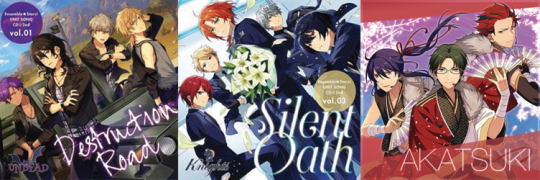
Although Ensemble Stars doesn’t have a lot of fully voiced story chapters in the game, they do have character voice clips and idol unit songs. The unit songs are very well produced and catchy. Each suit the style of music that each idol group represents: punk rock, traditional Japanese, cute pop, etc. My favourite songs are: Knight’s “Fight for Judge” and “Silent Oath”, UNDEAD’s “DESTRUCTION ROAD” and “Melody in the Dark”, and Akatsuki’s “百花繚乱、紅月夜 (Wild Blooming Flowers, Crimson Coloured Moon’s Night)” and “花燈の恋文 (Love Letter of the Brilliance of Cherry Blossoms).” I like listening to these songs when I do design work to keep me motivated and awake.

Story: 4/5 ♥♥♥♥♡
The overall story for Ensemble Stars is quite complicated and dramatic. As the player, you are a transfer student so you do not know much about the history and rivalry with each idol unit and members. The game heavily relies on the story and continues to build it through events and gachas. Usually, relationships between characters, backstories, or explanations slowly reveal themselves in event and gacha stories. For example, recently a new character named Madara entered the game. Since he is new and the only solo idol, his event explained his past relationship with some of the members of Ryuuseitai. Although the event didn’t explain too much about the other characters’ backstories like fans were hoping for, it did reveal some facts that we could debate and speculate about within the fandom. As I mentioned before, the Ensemble Stars! Wiki provides all the translations of the main, sub story, and past events and gachas. I haven’t read all the translations yet since there are quite a lot, but I’m sure when I do, I will create an even stronger emotional connection towards the characters I love.

Overall: 4.33/5 ♥♥♥♥♡
Ensemble Stars is an easy, fun, and addicting game that has easily become my newest obsession. The artwork is amazing, the characters are interesting and the storyline is worth reading. Although, it can be difficult to collect gems and cards since it is all based on luck and how often you play, I would still recommend it to beginners if they want a challenge and are determined enough to get their favourite character’s cards. Again, I don’t regret starting this game or throwing my money at it because it is an experience and an adventure I’m willing to make sacrifices for. I’ve created such a strong emotional connection with the characters that I wouldn’t want to just stop and throw it away.
#ensemble stars#enstars#ansuta#mobage#momobage#koga oogami#oogami koga#undead#fine#trickstar#switch#ryuuseitai#akatsuki#knights#valkyrie#2wink#rabits#mam#review#this game is death
5 notes
·
View notes
Text
How Technology Is Changing How We Treat Cross Country Movers
As it's already in the business's truck, the individual will have little option except to pay to receive his kidnapped possessions delivered to his new house. The business might also provide the choice of packaging your possessions to your benefit. Typically, the entire service moving companies offer not simply transit service but packing of products also. The extended distance they also wish to understand exactly what you want them to perform. In the long run they are there to serve their clients and will do what it takes to make sure their clients are satisfied with their move. Having said that, the majority of Melbourne that they can give you cost-effective and reasonable choices to obtain what's best for you. Professional moving businesses can begin with attracting their own packaging.
In the end, you must elect for an organization which caters to you with regular excellent service at fair prices. A provider is likely to be sure they deliver the best superior packing gear that you really feel safe that all your belongings will arrive at the destination without breaking up. Moving companies charge various prices and provide various services. Not only if the moving company answer all of your questions to your satisfaction, they need to have an extensive assortment of queries of their own. Moving companies can not provide you a proven quote on the telephone, but they're in a position to provide you with an overall idea of just how much you will be spending. All in all, they are a great selection for a person who is moving to some other place. You will find moving companies which don't actually provide insurance by utilizing their prices as well as being such, the lowest priced quoted price may not necessarily be the best cost.
A Moving Companies Success Story You'll Never Believe
Your relocation out of state might ask you to restructure your company to abide by regulations of this new site. Nowadays you can start to get ready for your move. If you're considering building a move like that you are going to want to speak to professionals that are conversant with global company relocation.
Moving overseas for your job sounds exciting. However, it is unlikely to be an effortless transition. The movement is part of a radical initiative called the LGBT Action Plan. If you're not considering an entire service move, you will want to select what providers is priority.
If you're moving out of this nation you may choose to keep a U.S. address or you might want to incorporate on your new website. Learn more concerning the culture of this nation you're moving to. Research about the climate of the nation you are likely to be moving to because it could be too different from what you're utilised to.
Assess how you're feeling about each organization. The business is strong, it is complex, and also in the vast majority of places, it's difficult to see. If your organization is quite large, you may want to acquire consent from local authorities to put large waste containers on the website. Moving companies take into consideration the weather condition since the temperature within the trailer can reach 140 degrees. Eventually you have selected the moving business! It is wise to interview several expert company relocation firms which specialize in corporate transfers.
Benefit from the convenience and flexibility of having the capability to rent your automobile when you desire, how you desire. The rented truck ought to be returned with no damage and with total tank. Moving trucks are available in a number of sizes and prices. Renting a moving truck is your main investment when it has to do with the authentic move. While renting a moving truck is definitely more affordable than hiring a moving company, it may still result in a few excess fees on the way. Moving trucks are the most necessary part of the key of life considering that the normal family generally moves once every five decades. The biggest truck given by Penske is the organization's 26 ft. truck.
Generally, truck rentals don't become excellent gas mileage. You also have to make certain that you decide on a truck rental that's in good shape. Finally, a moving truck rental is the perfect means to conserve strain and cash on another move.
Moving does not need to be a complicated clinic. From time to time, the move appears to spin out of control, and stress receives the very best of individuals. If you would like to deal with the transfer yourself, you should research truck leasing services. A very long distance move can be challenging to plan.
The organization can be attained over email and phone. Most companies only reimburse a tiny fraction of the worth of your damaged or lost possessions that's inadequate coverage. Most professional moving businesses of Tampa Florida will properly manage your items, but it's still a wonderful idea to be certain.
Whenever the moving company will deliver the color coded boxes will be a lot easier to recognize and put in the most suitable room. The majority of the moving companies put up the rate quote for assorted type of moving on the net. Therefore, it's vital that you choose the most suitable company based on your precise needs. The individuals can receive the proper moving company with the guidance of mover web site on the net. They can get the right moving company with the help of movers sites on the internet.
3 Reasons Your Moving Companies Near Me Is Broken (And How To Fix It)
If you're searching for a moving company that will appear on time, transfer your belongings with caution, and are simple to communicate with, look no longer. A moving company supplies you all of the services at a possible quantity. Residential moving businesses are extremely different and always offering different services for quite various cost and it is always hard to select which moving company is acceptable for you. They Another important thing to remember when searching for moving companies is that it should be affordable. To begin with, you're likely to need to see which residential moving company is likely to serve you the very best.
Our movers handle your belongings like they were their very own. Also be ready to invest more cash on the service as a result of surplus time it'll take for the movers to finish the job. The movers also need to be careful when unpacking belongings. Whenever your specialist movers arrive, it's going to be essential to provide them lots of room to do the job. The main reason for hiring the expert movers is they have skilled the art of packaging and moving the household items in different locations. As an example, you might require professional long distance movers based on just how far the planned move is.
Be certain to ask any questions you've got about the extended space moving quote prior to creating the last decision. Our long distance moving requires a particular set of skills and expertise to have the ability to allow it to succeed. Moving across extended distances can frequently be a daunting experience. When it has to do with the very long distance moving then you have got to put more care as you're going there to get a longer duration and cannot return if you left anything on your previous dwelling place. There are a number of reasons to employ a lengthy distance moving company.
Moving could be quite exhausting work. Every movement differs, so therefore it's crucial to pick a moving company that is ideal for you. 1 wrong move and it may never sound the exact same.
Whenever you have depended on a moving company the next thing you have to do is receiving composed appraisals. It's similarly necessary for you to watch the moving organization you expect managing is one that has security. Also, you have to discover a decent moving company.
Such providers are especially ideal for business attire like suits which will want to get pressed. Thus, when searching around for trained and skilled Columbia SC movers, then you're advised to thoroughly investigate the value-added services that they supply together with their charges and pick the ones which best suit your requirements and your financial plan. You may pick from any or all of the moving labor services you need, then simply select from a list of Moving Help Service Providers which are made available in your region.
If you're organizing a move, be sure your favorite regional movers in Columbia SC are well equipped to handle most situations and take their profession seriously. Moving is a normal part of life, however you will rarely find anyone who actually enjoys the approach. At the same time, your relocation to a more compact place gets totally doable.
Moving is not simple, do not hesitate to request aid. Be certain the businesses provide the form of relocation you are searching for, while it is local or interstate. Local moves in a tiny town in the Midwest is going to be a lot less costly than comparable moves in New York.
When you begin looking at businesses to employ, among the very first things you ought to learn is if they're a part of the American Moving and Storage Association (AMSA). Other firms have a huge range of services you may gain from. Because there are a lot of different moving companies out there, you might wish to have a great quantity of time determining which one is going to be the most suitable for your moving requirements.
Some businesses will bill by the real things that you list on your own inventory. To begin with, check the standing of the very long distance moving company you're thinking about. Many professional moving firms also provide valuation so you'll be compensated if any damage happens during the moving process.
The Most Common Long Distance Moving Companies Debate Isn't As Black And White As You Might Think
If you're considering moving and you're not certain how to select the correct kind of moving business to employ, you're certainly not alone. Moving companies have various services based on the customer's requirements. If you are spending your moving business by the hour, then they might not move as fast as you would like. In addition, you need to ask the local moving company should they include an insurance policy sum in the quotation.
Even in the event you've hired movers to aid you with packing, moving, and unloading, there are tons of things you need to watch to yourself to guarantee a smooth transition. You might also hunt for the neighborhood movers by simply going through the magazines and journals that are occasionally published. Local movers and their clients have to be on the exact same webpage to accomplish a successful movement.
You should address a plumber who will give you cheap storage since you solve your accommodation troubles. Local movers may also help you throughout the whole moving process, and it's very straightforward to have in touch with the business enterprise. Local movers in Boston are the absolute best people to find the most suitable answers from when you're representing a company which believes transferring its operations.
You should not be scared to call the local movers for a free estimate on what it will take to move your property, and you also can talk about the different moving choices, what the procedure will entail, and precisely what you should expect the day that the relocation occurs. Our regional movers have the experience in receiving your belongings across town in a speedy and effective way. You may expect our neighborhood PA movers to find the task done.
The movers did a bad job. Who knows you could just learn there are far more competitive movers that may qualify to your kind of transfer. You will have the ability to ask the furniture movers to provide a checklist.
youtube
As you prepare for your cross-county play, however prepared you believe that you're, you are likely to discover that you've a great deal on your plate. A cross-country move demands careful choreography so as to prevent unexpected hassles. If you're considering a lengthy distance transfer to some other nation, then you're facing the requirement for cross country movers.
youtube
So You've Bought Cross Country Movers ... Now What?
Some people today wish to move from 1 country to another because of the work relocation or due to the new job, moving from 1 nation to another that is about 1000 miles away from your house place is actually a demanding in addition to the risky job. As you are moving across the nation, pay particular attention to your private spending. Actually, oftentimes, it is the least expensive method to move upon the nation. When you've finalized a cross country moving company, the previous step is to enquire whether there are any hidden charges. A cross country moving company is just like its connections. By making the very best cross country moving companies compete for your company, you always win with the least expensive prices.
You have to fetch dependable and amazing movers to be able to acquire the very best services. Untrained movers don't have the correct packing equipment and the expertise for executing the work correctly. Little and massive removals Professional movers take care of numerous distinct removals.
Some individuals perform the move by themselves, or opt to employ a moving firm. The very first and foremost thing you ought to do prior to your relocation would be to knock out things which you don't want and find useful. Being aware of what to prepare and do before and during the move, you'll have the ability to make things less problematic for you. Moving can be difficult for nearly every member of their family. As an pricey entertainment, moreover, it deserves a fantastic move.
Seasoned movers have handled an number of scenarios and will find a means to take care of any problem that suddenly comes up on moving day. Professional movers should also offer you sufficient insurance policy coverage based on this sort of service you require of them. If you're looking for a very good expert mover, there are a few local moving companies that it is possible to pick from.
What you need to do is find cheap movers NYC who are prepared to reduce moving cost when helping you to perform a few of the moving tasks successfully. So, the moment you're selecting the cheap mover's cheap movers Aurora CO, then make certain you're getting scheduling choices. Cheap movers in Los Angeles generally offer you various choices to choose from.
0 notes
Text
How To Write The Best Google Ads Copy & Back It Up on Landing Pages
Crafting strong ad copy on Google Ads isn’t hard, but to do it right, we have to flex both art and science muscles. We’re only given a small number of characters on search engine results pages (SERPs), so we have to make them count.
When writing copy, it’s important to think about the experience your visitor is having from query, to ad copy, to landing page.
If there’s a hiccup along the way or they feel like they might be going down the wrong path, they’ll hit the back button. Worse, they might conduct another search and find another company ready to meet their needs. Additionally, as much as we would like it to, no ad can convert a prospect without a strong accompanying landing page.
There’s no one-size-fits-all approach to ad writing, but following some best practices will help make us more successful. With that in mind, below are eight tips for writing the best ad copy (backed up with landing pages) for Google Ads:
1. Leverage Keywords Where Possible
A staple best practice of ad copywriting is to include keywords in ad copy to mirror the searcher’s query. By parroting back phrases similar to what they searched for, we’re telling them that they’re in the right place.
Keywords in Ad Copy
In the real world, if you order something from a coffee shop, you expect them to call out exactly what you ordered when it’s ready. If you order an Americano and the barista yells out “Coffee!”, they’re technically correct. But it’s not immediately clear to you that it’s your coffee or someone else’s.
Adding keywords to ad copy is fairly simple, but it’s important to make sure the keywords are being used well. Don’t just stuff in as many as you can. An ad that’s saturated with keywords likely doesn’t convey any message and could be worse than an ad with no keywords. It’s more important to accurately articulate what you’re selling.
Keyword placement in ads can also play a large role. I highly recommend you test keyword placement within your ads to see what works best. Sometimes it’s best in Headline 1. Sometimes Headline 2. And sometimes it’s best used in a sentence in a description. You won’t know until you test!
That’s just the ad copy component. What about the landing page?
Keywords in Landing Pages
Using search keywords in the headlines and/or text at the top of a landing page tells the visitor, “You’re in the right place. We have what you’re looking for.” (“This is your caffè Americano,” if you will.)
Unfortunately, swapping text on landing pages isn’t quite as easy as doing it in ad copy. If your landing pages need to be hardcoded, then logic might suggest that you need to create a new page for each different keyword phrase you’re targeting.
In my opinion, though, unless you’re driving extremely high traffic through those pages, this isn’t necessary.
Instead, choose some common phrases, likely the most highly searched variants of your keywords, and turn them into headlines. Ideally, the number of pages you’ll need to create will go down depending on the number of keyword phrases you have in your account.
Let’s take an example: I’m advertising scheduling software for hourly employees.
A basic headline could be “Employee Scheduling Software,” a typical query in the account. Easy and to the point. But the page that uses this headline could easily be used for phrases that are close to, but not exactly, that phrase: scheduling employees, tools for employee scheduling, schedule hourly employees, etc.
Try to write headlines that can work for multiple phrases to limit the number of pages you need to make. And do this while also getting as close as possible to the initial search query.
PRO TIP: If you build your page with Unbounce, you can also use Dynamic Text Replacement (DTR) to help you match your landing page copy to your ads, saving you bundles of time that you can spend more effectively.
2. Be As Specific As the User’s Query
Every time a person conducts a search, their query holds a degree of specificity. It’s important that you match their specificity as much as possible.
If they’re not being specific, in other words, you can keep your ad copy relatively broad and cover the basics. If they are being more specific, you should try to match whatever their query is.
Let’s use the example of shoes. Here are some ways you could adjust your copy based on differing degrees of searches:
An example of how ad copy matches a search query.
The only piece adjusted is the first headline, but it creates a much tighter theme with the query and lets them know they’re in the right place.
The same principle holds through with the landing page and is potentially even more important than the copy itself. One of the keys to conversion rate optimization is giving your prospects what they need. Continuing the shoe example above, here are potential pages that you would want to direct people to:
“Shoes”: http://www.example.com
“Women’s shoes”: http://www.example.com/women
“Women’s Nike shoes”: http://bit.ly/2H2PB5i
Obviously, this is a fake website, but the landing pages used match as close as they can to the query. Each time we add a word—from “shoes” to “women’s shoes” and from “women’s shoes” to “women’s nike shoes”—we learn more about their need and can match that with a more specific landing page.
Each time someone searches, they’re telling you what they want. Listen to them and deliver results with as much specificity as you can.
3. Always Include a Call To Action
When it all comes down to it, we’re running ads because we want the visitor to take a specific action. For some, that might be making a purchase. For others, it might mean filling out a lead form. No matter the action, it’s important to either use that phrasing in the ad copy or give them a clue as to what you want.
Using a call to action in ad copy helps frame the visitor experience. It can operate similarly to the Prequalifying ad copy mentioned in the next section. Once they understand what you want them to do, it can help weed out people who aren’t interested. This practice helps save you the cost of the click.
Once a visitor has had their expectations set with the ad copy, they should click through to a landing page that mirrors that same call to action. If you’ve asked them to “Buy Now” in your copy, they should be given the opportunity to buy on the landing page. If you’ve only asked them to “Learn More” in your copy, then be sure the landing page houses the information they need to decide whether to make a purchase down the road.
4. Test Psychological Approaches to Find the Right Fit
The messaging used in ad copy can be a critical selling point, but it need not be boring. If anything, SERPs are getting overcrowded with the same type of bland messaging for all ad slots. That’s an opportunity for you to stand out from the crowd.
It’s important to test the different psychological approaches to ad copy to know which performs best with your target audience. Here’s a quick rundown of the major types of ad copy approaches:
Features: highlighting the physical or intangible aspects of the product/service. (Memory foam)
Benefits: calling out the positive outcomes the visitor will have from the product/service. (More restful sleep)
Problem: focus on the actual issue at hand to relate to the problem the visitor is trying to solve. (Tired of Wasting Time?)
Solution: focus on the solution to the problem the visitor is facing. (Save Time)
Testimonials: using actual feedback/testimonials to leverage social proof. (“This product has changed my life.”)
Reviews: third-party reviews of the product/service, not from customers.
Top of the Class: calling out any awards, ratings, etc. to show you’re the best. (Best in category award, 2018)
Prequalifying: weeding out people who might not be a good fit for your service before they click. (“Luxury Tours,” attempting to weed out bargain travelers)
Once you’ve tested what works best, mirror that on the landing page to create a cohesive feel from start to finish. Choose images and calls to action that mirror those approaches where possible.
5. Don’t Sell a False Bill of Goods
I’ve mentioned this before, but it bears repeating, and so it’s own line item on this list:
Your landing page should back up what’s in your ad copy.
Ad copy and landing pages need to work together. No matter what copy is used, it’s important that the message and offer follow through to the landing page for a cohesive experience.
When this connection breaks down, it could look something like this:
A prospective customer conducts a search, clicks on an ad that says “20% off” only to get to the landing page a find out the offer is expired—or, worse, there’s no mention of it whatsoever. That’s frustrating!
As we discussed earlier, it’s important to get the visitor thinking about the call to action at the ad copy stage. If that call to action isn’t on the landing page, then those precious characters in the ad copy, as well as the price you paid for the click, were wasted. They are no longer primed to complete the conversion action you asked.
6. Use Ad Extensions Like Crazy
Ad extensions are pretty much exactly what they sound like: they’re additional areas of text that can extend the size of an ad. There are many different kinds of ad extensions at our disposal. Here’s the full list from Google Ads:
Take advantage of every extension that fits your business, but don’t forget the main reason for your ad.
Each has its use and purpose, and I’m not going to go into detail on each one. The ones that lend themselves to nearly every business are Sitelinks, Callout Extensions, and Structured Snippets.
Sitelinks
Sitelinks are simply additional text and links that can show up with ad copy. Ideally, you should leverage these to add supporting information to the primary ad copy in the ad group. These are essentially functioning as in-site navigation, but directly in the SERPs.
In the image above, the Sitelinks direct users to currently popular products and sections of Nike’s website.
Callout Extensions
Callout extensions are even easier than Sitelinks. These are simply a line of text, no longer than 25 characters.
Callout extensions are easy to implement.
This text can be used to put just about anything that helps support the ad. Similar to Sitelinks, however, it’s best if this text can be complementary and not repeat what’s in the original ad. These can be a quick list of features, benefits, or more information (like “Free Shipping”) if it didn’t fit in the ad text.
Structured Snippets
Lastly, Structured Snippets let you create a list within an ad extension. Simply pick the Header you want to start the list, then add in values below with 25 characters each.
Callout extensions are easy to implement.
There are a number of other ad extensions that can be added to any campaign. More often than not, it’s best to have as many ad extensions types in place as possible so any of them can be called up at any point.
However, there is one caveat to this. Don’t forget about the main reason for the ad. Sometimes one ad extension can be throttled and another type will be shown more often, potentially causing performance to drop. Keep this in mind when setting up ad extensions. Have as full of coverage as you can, but don’t sacrifice performance for ad real estate.
EDITOR’S NOTE: For more about how extensions can help your ads stand out from the competition, you’ll want to read Ryan Gould’s latest post on quick ways to breathe new life into your Google Ads.
7. Leverage Dynamic Ad Features
In addition to ad extensions, there are other features we can use to ensure that our ads are as impressive as possible. Below is a screenshot of the three dynamic ad features offered on the Google Ads platform. You can trigger this dropdown by typing in a { into the ad creation screen.
Typing a { brings up the dropdown for Keyword Insertion, Countdowns, and IF functions.
Keyword Insertion
Keyword Insertion (formerly Dynamic Keyword Insertion or DKI) is the most basic version of dynamic ads and is best used if your campaign structure isn’t strongly segmented. Keyword Insertion allows advertisers to substitute a search keyword in place of default text in your ad copy. However, the text with the keyword will not be used if the combination of the text plus DKI is too long. Take a look at the example below:
Using Keyword Insertion.
Here, I added “Women’s Shoes” as the placeholder text. If the keyword that triggers this ad is fewer than 13 characters long, then that keyword text will be added in place of “Women’s Shoes.”
For instance, if the keyword was “Tennis Shoes,” the headline will now read “Great Prices on Tennis Shoes.” But if the keyword is too long, like “women’s running shoes,” then the headline will read “Great Prices on Women’s Shoes” because the placeholder text will stay.
IF Functions
This dynamic ad feature lets advertisers create “if, then” statements within ad copy based on a user’s device or the audience they belong to.
Using powerful IF Functions is simpler than it seems.
IF Functions can be amazingly powerful if you have a different call to action for someone on a mobile device versus desktop (“Call Us” versus “Fill Out the Form”) or if you want to offer discounts to users within specific audiences, like existing customers.
IF Functions have some really powerful uses. You can read more in this post by Joe Martinez to get more ideas on how you can use them.
If you leverage IF Functions to create a different call to action or make a new offer depending on device or audience, it’s essential to make sure it’s carried over to the landing page. Be sure you’re not teasing a 20% discount in the ad copy, then not offering it once they get to the landing page (more on this below).
Countdowns
Lastly, Countdowns can be an amazing way to create urgency in ad copy without needing manual ad shifts for each day, hour, or minute until the offer expires. All we advertisers have to do is fill out the builder widget and Google will do the rest!
Countdowns add urgency to your copy.
With Countdowns, it’s imperative that the time in the ad copy and the time on site match up as closely as possible. Pay attention to time zones to be sure the offer isn’t ending too early or running too late in the ads. Each of these could cause performance changes or bad brand association depending on the error made.
8. #1 Rule: We’re Always Talking to People
Follow as many of the best practices above that you can, but don’t forget the reason we’re here: potential customers!
In every ad and on every landing page, we’re always talking to people. The final thing we should do before launching any new copy or landing page is to give it a gut check:
Is this something I would click on?
Does this sound appealing?
Does this ad make sense or is it just a bunch of keywords jammed together?
Does the landing page answer the promise set in the ad copy?
Conclusion
Writing ad copy for Google Ads is a combination of art and science. It requires that you look beyond the ad itself to the landing page. There are some technical best practices to follow that I’ve outlined here, but we also need to tap into our artistic side when speaking to other people. If ad copy were purely algorithmic, after all, everyone would be rich by now.
Give these best practices a shot and let us know your results! What tactic was the biggest help to you? What have you seen work best in your ad copy? Share with us in the comments!
How To Write The Best Google Ads Copy & Back It Up on Landing Pages syndicated from https://unbounce.com
0 notes
Text
How To Write The Best Google Ads Copy & Back It Up on Landing Pages
Crafting strong ad copy on Google Ads isn’t hard, but to do it right, we have to flex both art and science muscles. We’re only given a small number of characters on search engine results pages (SERPs), so we have to make them count.
When writing copy, it’s important to think about the experience your visitor is having from query, to ad copy, to landing page.
If there’s a hiccup along the way or they feel like they might be going down the wrong path, they’ll hit the back button. Worse, they might conduct another search and find another company ready to meet their needs. Additionally, as much as we would like it to, no ad can convert a prospect without a strong accompanying landing page.
There’s no one-size-fits-all approach to ad writing, but following some best practices will help make us more successful. With that in mind, below are eight tips for writing the best ad copy (backed up with landing pages) for Google Ads:
1. Leverage Keywords Where Possible
A staple best practice of ad copywriting is to include keywords in ad copy to mirror the searcher’s query. By parroting back phrases similar to what they searched for, we’re telling them that they’re in the right place.
Keywords in Ad Copy
In the real world, if you order something from a coffee shop, you expect them to call out exactly what you ordered when it’s ready. If you order an Americano and the barista yells out “Coffee!”, they’re technically correct. But it’s not immediately clear to you that it’s your coffee or someone else’s.
Adding keywords to ad copy is fairly simple, but it’s important to make sure the keywords are being used well. Don’t just stuff in as many as you can. An ad that’s saturated with keywords likely doesn’t convey any message and could be worse than an ad with no keywords. It’s more important to accurately articulate what you’re selling.
Keyword placement in ads can also play a large role. I highly recommend you test keyword placement within your ads to see what works best. Sometimes it’s best in Headline 1. Sometimes Headline 2. And sometimes it’s best used in a sentence in a description. You won’t know until you test!
That’s just the ad copy component. What about the landing page?
Keywords in Landing Pages
Using search keywords in the headlines and/or text at the top of a landing page tells the visitor, “You’re in the right place. We have what you’re looking for.” (“This is your caffè Americano,” if you will.)
Unfortunately, swapping text on landing pages isn’t quite as easy as doing it in ad copy. If your landing pages need to be hardcoded, then logic might suggest that you need to create a new page for each different keyword phrase you’re targeting.
In my opinion, though, unless you’re driving extremely high traffic through those pages, this isn’t necessary.
Instead, choose some common phrases, likely the most highly searched variants of your keywords, and turn them into headlines. Ideally, the number of pages you’ll need to create will go down depending on the number of keyword phrases you have in your account.
Let’s take an example: I’m advertising scheduling software for hourly employees.
A basic headline could be “Employee Scheduling Software,” a typical query in the account. Easy and to the point. But the page that uses this headline could easily be used for phrases that are close to, but not exactly, that phrase: scheduling employees, tools for employee scheduling, schedule hourly employees, etc.
Try to write headlines that can work for multiple phrases to limit the number of pages you need to make. And do this while also getting as close as possible to the initial search query.
PRO TIP: If you build your page with Unbounce, you can also use Dynamic Text Replacement (DTR) to help you match your landing page copy to your ads, saving you bundles of time that you can spend more effectively.
2. Be As Specific As the User’s Query
Every time a person conducts a search, their query holds a degree of specificity. It’s important that you match their specificity as much as possible.
If they’re not being specific, in other words, you can keep your ad copy relatively broad and cover the basics. If they are being more specific, you should try to match whatever their query is.
Let’s use the example of shoes. Here are some ways you could adjust your copy based on differing degrees of searches:
An example of how ad copy matches a search query.
The only piece adjusted is the first headline, but it creates a much tighter theme with the query and lets them know they’re in the right place.
The same principle holds through with the landing page and is potentially even more important than the copy itself. One of the keys to conversion rate optimization is giving your prospects what they need. Continuing the shoe example above, here are potential pages that you would want to direct people to:
“Shoes”: www.example.com
“Women’s shoes”: www.example.com/women
“Women’s Nike shoes”: www.example.com/women/nike
Obviously, this is a fake website, but the landing pages used match as close as they can to the query. Each time we add a word—from “shoes” to “women’s shoes” and from “women’s shoes” to “women’s nike shoes”—we learn more about their need and can match that with a more specific landing page.
Each time someone searches, they’re telling you what they want. Listen to them and deliver results with as much specificity as you can.
3. Always Include a Call To Action
When it all comes down to it, we’re running ads because we want the visitor to take a specific action. For some, that might be making a purchase. For others, it might mean filling out a lead form. No matter the action, it’s important to either use that phrasing in the ad copy or give them a clue as to what you want.
Using a call to action in ad copy helps frame the visitor experience. It can operate similarly to the Prequalifying ad copy mentioned in the next section. Once they understand what you want them to do, it can help weed out people who aren’t interested. This practice helps save you the cost of the click.
Once a visitor has had their expectations set with the ad copy, they should click through to a landing page that mirrors that same call to action. If you’ve asked them to “Buy Now” in your copy, they should be given the opportunity to buy on the landing page. If you’ve only asked them to “Learn More” in your copy, then be sure the landing page houses the information they need to decide whether to make a purchase down the road.
4. Test Psychological Approaches to Find the Right Fit
The messaging used in ad copy can be a critical selling point, but it need not be boring. If anything, SERPs are getting overcrowded with the same type of bland messaging for all ad slots. That’s an opportunity for you to stand out from the crowd.
It’s important to test the different psychological approaches to ad copy to know which performs best with your target audience. Here’s a quick rundown of the major types of ad copy approaches:
Features: highlighting the physical or intangible aspects of the product/service. (Memory foam)
Benefits: calling out the positive outcomes the visitor will have from the product/service. (More restful sleep)
Problem: focus on the actual issue at hand to relate to the problem the visitor is trying to solve. (Tired of Wasting Time?)
Solution: focus on the solution to the problem the visitor is facing. (Save Time)
Testimonials: using actual feedback/testimonials to leverage social proof. (“This product has changed my life.”)
Reviews: third-party reviews of the product/service, not from customers.
Top of the Class: calling out any awards, ratings, etc. to show you’re the best. (Best in category award, 2018)
Prequalifying: weeding out people who might not be a good fit for your service before they click. (“Luxury Tours,” attempting to weed out bargain travelers)
Once you’ve tested what works best, mirror that on the landing page to create a cohesive feel from start to finish. Choose images and calls to action that mirror those approaches where possible.
5. Don’t Sell a False Bill of Goods
I’ve mentioned this before, but it bears repeating, and so it’s own line item on this list:
Your landing page should back up what’s in your ad copy.
Ad copy and landing pages need to work together. No matter what copy is used, it’s important that the message and offer follow through to the landing page for a cohesive experience.
When this connection breaks down, it could look something like this:
A prospective customer conducts a search, clicks on an ad that says “20% off” only to get to the landing page a find out the offer is expired—or, worse, there’s no mention of it whatsoever. That’s frustrating!
As we discussed earlier, it’s important to get the visitor thinking about the call to action at the ad copy stage. If that call to action isn’t on the landing page, then those precious characters in the ad copy, as well as the price you paid for the click, were wasted. They are no longer primed to complete the conversion action you asked.
6. Use Ad Extensions Like Crazy
Ad extensions are pretty much exactly what they sound like: they’re additional areas of text that can extend the size of an ad. There are many different kinds of ad extensions at our disposal. Here’s the full list from Google Ads:
Take advantage of every extension that fits your business, but don’t forget the main reason for your ad.
Each has its use and purpose, and I’m not going to go into detail on each one. The ones that lend themselves to nearly every business are Sitelinks, Callout Extensions, and Structured Snippets.
Sitelinks
Sitelinks are simply additional text and links that can show up with ad copy. Ideally, you should leverage these to add supporting information to the primary ad copy in the ad group. These are essentially functioning as in-site navigation, but directly in the SERPs.
In the image above, the Sitelinks direct users to currently popular products and sections of Nike’s website.
Callout Extensions
Callout extensions are even easier than Sitelinks. These are simply a line of text, no longer than 25 characters.
Callout extensions are easy to implement.
This text can be used to put just about anything that helps support the ad. Similar to Sitelinks, however, it’s best if this text can be complementary and not repeat what’s in the original ad. These can be a quick list of features, benefits, or more information (like “Free Shipping”) if it didn’t fit in the ad text.
Structured Snippets
Lastly, Structured Snippets let you create a list within an ad extension. Simply pick the Header you want to start the list, then add in values below with 25 characters each.
Callout extensions are easy to implement.
There are a number of other ad extensions that can be added to any campaign. More often than not, it’s best to have as many ad extensions types in place as possible so any of them can be called up at any point.
However, there is one caveat to this. Don’t forget about the main reason for the ad. Sometimes one ad extension can be throttled and another type will be shown more often, potentially causing performance to drop. Keep this in mind when setting up ad extensions. Have as full of coverage as you can, but don’t sacrifice performance for ad real estate.
EDITOR’S NOTE: For more about how extensions can help your ads stand out from the competition, you’ll want to read Ryan Gould’s latest post on quick ways to breathe new life into your Google Ads.
7. Leverage Dynamic Ad Features
In addition to ad extensions, there are other features we can use to ensure that our ads are as impressive as possible. Below is a screenshot of the three dynamic ad features offered on the Google Ads platform. You can trigger this dropdown by typing in a { into the ad creation screen.
Typing a { brings up the dropdown for Keyword Insertion, Countdowns, and IF functions.
Keyword Insertion
Keyword Insertion (formerly Dynamic Keyword Insertion or DKI) is the most basic version of dynamic ads and is best used if your campaign structure isn’t strongly segmented. Keyword Insertion allows advertisers to substitute a search keyword in place of default text in your ad copy. However, the text with the keyword will not be used if the combination of the text plus DKI is too long. Take a look at the example below:
Using Keyword Insertion.
Here, I added “Women’s Shoes” as the placeholder text. If the keyword that triggers this ad is fewer than 13 characters long, then that keyword text will be added in place of “Women’s Shoes.”
For instance, if the keyword was “Tennis Shoes,” the headline will now read “Great Prices on Tennis Shoes.” But if the keyword is too long, like “women’s running shoes,” then the headline will read “Great Prices on Women’s Shoes” because the placeholder text will stay.
IF Functions
This dynamic ad feature lets advertisers create “if, then” statements within ad copy based on a user’s device or the audience they belong to.
Using powerful IF Functions is simpler than it seems.
IF Functions can be amazingly powerful if you have a different call to action for someone on a mobile device versus desktop (“Call Us” versus “Fill Out the Form”) or if you want to offer discounts to users within specific audiences, like existing customers.
IF Functions have some really powerful uses. You can read more in this post by Joe Martinez to get more ideas on how you can use them.
If you leverage IF Functions to create a different call to action or make a new offer depending on device or audience, it’s essential to make sure it’s carried over to the landing page. Be sure you’re not teasing a 20% discount in the ad copy, then not offering it once they get to the landing page (more on this below).
Countdowns
Lastly, Countdowns can be an amazing way to create urgency in ad copy without needing manual ad shifts for each day, hour, or minute until the offer expires. All we advertisers have to do is fill out the builder widget and Google will do the rest!
Countdowns add urgency to your copy.
With Countdowns, it’s imperative that the time in the ad copy and the time on site match up as closely as possible. Pay attention to time zones to be sure the offer isn’t ending too early or running too late in the ads. Each of these could cause performance changes or bad brand association depending on the error made.
8. #1 Rule: We’re Always Talking to People
Follow as many of the best practices above that you can, but don’t forget the reason we’re here: potential customers!
In every ad and on every landing page, we’re always talking to people. The final thing we should do before launching any new copy or landing page is to give it a gut check:
Is this something I would click on?
Does this sound appealing?
Does this ad make sense or is it just a bunch of keywords jammed together?
Does the landing page answer the promise set in the ad copy?
Conclusion
Writing ad copy for Google Ads is a combination of art and science. It requires that you look beyond the ad itself to the landing page. There are some technical best practices to follow that I’ve outlined here, but we also need to tap into our artistic side when speaking to other people. If ad copy were purely algorithmic, after all, everyone would be rich by now.
Give these best practices a shot and let us know your results! What tactic was the biggest help to you? What have you seen work best in your ad copy? Share with us in the comments!
from RSSMix.com Mix ID 8217493 https://unbounce.com/ppc/write-best-google-ads-copy/
0 notes
Text
How To Write The Best Google Ads Copy & Back It Up on Landing Pages
Crafting strong ad copy on Google Ads isn’t hard, but to do it right, we have to flex both art and science muscles. We’re only given a small number of characters on search engine results pages (SERPs), so we have to make them count.
When writing copy, it’s important to think about the experience your visitor is having from query, to ad copy, to landing page.
If there’s a hiccup along the way or they feel like they might be going down the wrong path, they’ll hit the back button. Worse, they might conduct another search and find another company ready to meet their needs. Additionally, as much as we would like it to, no ad can convert a prospect without a strong accompanying landing page.
There’s no one-size-fits-all approach to ad writing, but following some best practices will help make us more successful. With that in mind, below are eight tips for writing the best ad copy (backed up with landing pages) for Google Ads:
1. Leverage Keywords Where Possible
A staple best practice of ad copywriting is to include keywords in ad copy to mirror the searcher’s query. By parroting back phrases similar to what they searched for, we’re telling them that they’re in the right place.
Keywords in Ad Copy
In the real world, if you order something from a coffee shop, you expect them to call out exactly what you ordered when it’s ready. If you order an Americano and the barista yells out “Coffee!”, they’re technically correct. But it’s not immediately clear to you that it’s your coffee or someone else’s.
Adding keywords to ad copy is fairly simple, but it’s important to make sure the keywords are being used well. Don’t just stuff in as many as you can. An ad that’s saturated with keywords likely doesn’t convey any message and could be worse than an ad with no keywords. It’s more important to accurately articulate what you’re selling.
Keyword placement in ads can also play a large role. I highly recommend you test keyword placement within your ads to see what works best. Sometimes it’s best in Headline 1. Sometimes Headline 2. And sometimes it’s best used in a sentence in a description. You won’t know until you test!
That’s just the ad copy component. What about the landing page?
Keywords in Landing Pages
Using search keywords in the headlines and/or text at the top of a landing page tells the visitor, “You’re in the right place. We have what you’re looking for.” (“This is your caffè Americano,” if you will.)
Unfortunately, swapping text on landing pages isn’t quite as easy as doing it in ad copy. If your landing pages need to be hardcoded, then logic might suggest that you need to create a new page for each different keyword phrase you’re targeting.
In my opinion, though, unless you’re driving extremely high traffic through those pages, this isn’t necessary.
Instead, choose some common phrases, likely the most highly searched variants of your keywords, and turn them into headlines. Ideally, the number of pages you’ll need to create will go down depending on the number of keyword phrases you have in your account.
Let’s take an example: I’m advertising scheduling software for hourly employees.
A basic headline could be “Employee Scheduling Software,” a typical query in the account. Easy and to the point. But the page that uses this headline could easily be used for phrases that are close to, but not exactly, that phrase: scheduling employees, tools for employee scheduling, schedule hourly employees, etc.
Try to write headlines that can work for multiple phrases to limit the number of pages you need to make. And do this while also getting as close as possible to the initial search query.
PRO TIP: If you build your page with Unbounce, you can also use Dynamic Text Replacement (DTR) to help you match your landing page copy to your ads, saving you bundles of time that you can spend more effectively.
2. Be As Specific As the User’s Query
Every time a person conducts a search, their query holds a degree of specificity. It’s important that you match their specificity as much as possible.
If they’re not being specific, in other words, you can keep your ad copy relatively broad and cover the basics. If they are being more specific, you should try to match whatever their query is.
Let’s use the example of shoes. Here are some ways you could adjust your copy based on differing degrees of searches:
An example of how ad copy matches a search query.
The only piece adjusted is the first headline, but it creates a much tighter theme with the query and lets them know they’re in the right place.
The same principle holds through with the landing page and is potentially even more important than the copy itself. One of the keys to conversion rate optimization is giving your prospects what they need. Continuing the shoe example above, here are potential pages that you would want to direct people to:
“Shoes”: www.example.com
“Women’s shoes”: www.example.com/women
“Women’s Nike shoes”: www.example.com/women/nike
Obviously, this is a fake website, but the landing pages used match as close as they can to the query. Each time we add a word—from “shoes” to “women’s shoes” and from “women’s shoes” to “women’s nike shoes”—we learn more about their need and can match that with a more specific landing page.
Each time someone searches, they’re telling you what they want. Listen to them and deliver results with as much specificity as you can.
3. Always Include a Call To Action
When it all comes down to it, we’re running ads because we want the visitor to take a specific action. For some, that might be making a purchase. For others, it might mean filling out a lead form. No matter the action, it’s important to either use that phrasing in the ad copy or give them a clue as to what you want.
Using a call to action in ad copy helps frame the visitor experience. It can operate similarly to the Prequalifying ad copy mentioned in the next section. Once they understand what you want them to do, it can help weed out people who aren’t interested. This practice helps save you the cost of the click.
Once a visitor has had their expectations set with the ad copy, they should click through to a landing page that mirrors that same call to action. If you’ve asked them to “Buy Now” in your copy, they should be given the opportunity to buy on the landing page. If you’ve only asked them to “Learn More” in your copy, then be sure the landing page houses the information they need to decide whether to make a purchase down the road.
4. Test Psychological Approaches to Find the Right Fit
The messaging used in ad copy can be a critical selling point, but it need not be boring. If anything, SERPs are getting overcrowded with the same type of bland messaging for all ad slots. That’s an opportunity for you to stand out from the crowd.
It’s important to test the different psychological approaches to ad copy to know which performs best with your target audience. Here’s a quick rundown of the major types of ad copy approaches:
Features: highlighting the physical or intangible aspects of the product/service. (Memory foam)
Benefits: calling out the positive outcomes the visitor will have from the product/service. (More restful sleep)
Problem: focus on the actual issue at hand to relate to the problem the visitor is trying to solve. (Tired of Wasting Time?)
Solution: focus on the solution to the problem the visitor is facing. (Save Time)
Testimonials: using actual feedback/testimonials to leverage social proof. (“This product has changed my life.”)
Reviews: third-party reviews of the product/service, not from customers.
Top of the Class: calling out any awards, ratings, etc. to show you’re the best. (Best in category award, 2018)
Prequalifying: weeding out people who might not be a good fit for your service before they click. (“Luxury Tours,” attempting to weed out bargain travelers)
Once you’ve tested what works best, mirror that on the landing page to create a cohesive feel from start to finish. Choose images and calls to action that mirror those approaches where possible.
5. Don’t Sell a False Bill of Goods
I’ve mentioned this before, but it bears repeating, and so it’s own line item on this list:
Your landing page should back up what’s in your ad copy.
Ad copy and landing pages need to work together. No matter what copy is used, it’s important that the message and offer follow through to the landing page for a cohesive experience.
When this connection breaks down, it could look something like this:
A prospective customer conducts a search, clicks on an ad that says “20% off” only to get to the landing page a find out the offer is expired—or, worse, there’s no mention of it whatsoever. That’s frustrating!
As we discussed earlier, it’s important to get the visitor thinking about the call to action at the ad copy stage. If that call to action isn’t on the landing page, then those precious characters in the ad copy, as well as the price you paid for the click, were wasted. They are no longer primed to complete the conversion action you asked.
6. Use Ad Extensions Like Crazy
Ad extensions are pretty much exactly what they sound like: they’re additional areas of text that can extend the size of an ad. There are many different kinds of ad extensions at our disposal. Here’s the full list from Google Ads:
Take advantage of every extension that fits your business, but don’t forget the main reason for your ad.
Each has its use and purpose, and I’m not going to go into detail on each one. The ones that lend themselves to nearly every business are Sitelinks, Callout Extensions, and Structured Snippets.
Sitelinks
Sitelinks are simply additional text and links that can show up with ad copy. Ideally, you should leverage these to add supporting information to the primary ad copy in the ad group. These are essentially functioning as in-site navigation, but directly in the SERPs.
In the image above, the Sitelinks direct users to currently popular products and sections of Nike’s website.
Callout Extensions
Callout extensions are even easier than Sitelinks. These are simply a line of text, no longer than 25 characters.
Callout extensions are easy to implement.
This text can be used to put just about anything that helps support the ad. Similar to Sitelinks, however, it’s best if this text can be complementary and not repeat what’s in the original ad. These can be a quick list of features, benefits, or more information (like “Free Shipping”) if it didn’t fit in the ad text.
Structured Snippets
Lastly, Structured Snippets let you create a list within an ad extension. Simply pick the Header you want to start the list, then add in values below with 25 characters each.
Callout extensions are easy to implement.
There are a number of other ad extensions that can be added to any campaign. More often than not, it’s best to have as many ad extensions types in place as possible so any of them can be called up at any point.
However, there is one caveat to this. Don’t forget about the main reason for the ad. Sometimes one ad extension can be throttled and another type will be shown more often, potentially causing performance to drop. Keep this in mind when setting up ad extensions. Have as full of coverage as you can, but don’t sacrifice performance for ad real estate.
EDITOR’S NOTE: For more about how extensions can help your ads stand out from the competition, you’ll want to read Ryan Gould’s latest post on quick ways to breathe new life into your Google Ads.
7. Leverage Dynamic Ad Features
In addition to ad extensions, there are other features we can use to ensure that our ads are as impressive as possible. Below is a screenshot of the three dynamic ad features offered on the Google Ads platform. You can trigger this dropdown by typing in a { into the ad creation screen.
Typing a { brings up the dropdown for Keyword Insertion, Countdowns, and IF functions.
Keyword Insertion
Keyword Insertion (formerly Dynamic Keyword Insertion or DKI) is the most basic version of dynamic ads and is best used if your campaign structure isn’t strongly segmented. Keyword Insertion allows advertisers to substitute a search keyword in place of default text in your ad copy. However, the text with the keyword will not be used if the combination of the text plus DKI is too long. Take a look at the example below:
Using Keyword Insertion.
Here, I added “Women’s Shoes” as the placeholder text. If the keyword that triggers this ad is fewer than 13 characters long, then that keyword text will be added in place of “Women’s Shoes.”
For instance, if the keyword was “Tennis Shoes,” the headline will now read “Great Prices on Tennis Shoes.” But if the keyword is too long, like “women’s running shoes,” then the headline will read “Great Prices on Women’s Shoes” because the placeholder text will stay.
IF Functions
This dynamic ad feature lets advertisers create “if, then” statements within ad copy based on a user’s device or the audience they belong to.
Using powerful IF Functions is simpler than it seems.
IF Functions can be amazingly powerful if you have a different call to action for someone on a mobile device versus desktop (“Call Us” versus “Fill Out the Form”) or if you want to offer discounts to users within specific audiences, like existing customers.
IF Functions have some really powerful uses. You can read more in this post by Joe Martinez to get more ideas on how you can use them.
If you leverage IF Functions to create a different call to action or make a new offer depending on device or audience, it’s essential to make sure it’s carried over to the landing page. Be sure you’re not teasing a 20% discount in the ad copy, then not offering it once they get to the landing page (more on this below).
Countdowns
Lastly, Countdowns can be an amazing way to create urgency in ad copy without needing manual ad shifts for each day, hour, or minute until the offer expires. All we advertisers have to do is fill out the builder widget and Google will do the rest!
Countdowns add urgency to your copy.
With Countdowns, it’s imperative that the time in the ad copy and the time on site match up as closely as possible. Pay attention to time zones to be sure the offer isn’t ending too early or running too late in the ads. Each of these could cause performance changes or bad brand association depending on the error made.
8. #1 Rule: We’re Always Talking to People
Follow as many of the best practices above that you can, but don’t forget the reason we’re here: potential customers!
In every ad and on every landing page, we’re always talking to people. The final thing we should do before launching any new copy or landing page is to give it a gut check:
Is this something I would click on?
Does this sound appealing?
Does this ad make sense or is it just a bunch of keywords jammed together?
Does the landing page answer the promise set in the ad copy?
Conclusion
Writing ad copy for Google Ads is a combination of art and science. It requires that you look beyond the ad itself to the landing page. There are some technical best practices to follow that I’ve outlined here, but we also need to tap into our artistic side when speaking to other people. If ad copy were purely algorithmic, after all, everyone would be rich by now.
Give these best practices a shot and let us know your results! What tactic was the biggest help to you? What have you seen work best in your ad copy? Share with us in the comments!
from RSSMix.com Mix ID 8217493 https://unbounce.com/ppc/write-best-google-ads-copy/
0 notes
Link
The US military budget is such a bloated monstrosity that it contains accounting errors that could finance two-thirds of the cost of a government-run single-payer health insurance system. All Americans could visit an unlimited array of doctors at no out of pocket cost. At least that’s a notion spreading on left-wing Twitter and endorsed and amplified by newly elected Rep. Alexandria Ocasio-Cortez, one of Democrats’ biggest 2018 sensations and an undeniable master at the fine art of staying in the public eye.
Unfortunately, it’s not true. The idea spread like a game of telephone from a Nation article to the US Congress while losing a crucial point of detail: The Pentagon’s accounting errors are genuinely enormous, but they’re also just accounting errors — they don’t represent actual money that can be spent on something else.
$21 TRILLION of Pentagon financial transactions “could not be traced, documented, or explained.”
$21T in Pentagon accounting errors. Medicare for All costs ~$32T.
That means 66% of Medicare for All could have been funded already by the Pentagon.
And that’s before our premiums. https://t.co/soT6GSmDSG
— Alexandria Ocasio-Cortez (@Ocasio2018) December 2, 2018
Misunderstandings fly around on Twitter all the time, and AOC’s level of policy knowledge is pretty typical for a member of Congress. But this particular flub is telling about progressive frustration over the double standard on military versus non-military spending, and also the fraught state of play regarding the push for a Medicare-for-all program.
Proponents of this vision have the political wind at their backs and continue to deploy the idea effectively to win intra-party arguments without really making any headway on the core obstacles to writing a Medicare-for-all bill that could become law. That said, to the extent that political power rather than concrete legislation is the goal, that’s probably for the best.
The underlying article by Dave Lindorff in the Nation that kicked this off is an investigative report into the Defense Department’s accounting practices. Lindorff reveals that Pentagon accounting is quite weak, that the department keeps flunking outside audits, that funds are shifted between accounts without proper oversight, and that overall documentation of what’s actually happening with the Pentagon’s vast budget is extremely poor.
Lindorff goes beyond these observations to allege that what’s happening amounts to deliberate fraud, the purpose of which is to persuade Congress to increase appropriations levels beyond what would otherwise be approved.
Critically, however, the passage of the article that Jordan Uhl quoted in the tweet that Ocasio-Cortez cited does not mean that there is $21 trillion in fraudulent or missing DOD spending between 1998 and 2015. Indeed, there simply hasn’t been $21 trillion in (nominal) Defense Department spending across the entirety of American history.
The $21 trillion figure represents a summation of poorly documented internal financial transfers, so that the same dollar can be transferred back and forth many times over. That’s how you end up with a total amount of mis-documented financial flows that far exceeds the amount of money that’s being actually spent.
That this is going on certainly tells a story. And it’s almost certainly true that if another agency was flubbing its internal financial controls to this degree, the American establishment wouldn’t tolerate it. But there’s no $21 trillion pot of gold that can be raided to pay for a comprehensive health insurance program, even though the United States really does spend an awful lot on the military.
President Donald Trump, echoing earlier calls by Barack Obama and George W. Bush but rendering them much more forcefully, has complained time and again that America’s NATO allies in Europe are not meeting their commitment to spend 2 percent of national income on their militaries.
The United States, meanwhile, spends much more than 2 percent of GDP on the quest for global military hegemony.
In a shrewd Washington Post article this summer, Jeff Stein asked what America could afford if it scaled back its military to that 2 percent target level. Slashing military spending from its current 3.5 percent of GDP level would free up about $3 trillion over the course of a decade. That would be enough to cut child poverty in half ($1.1 trillion), eliminate tuition at public colleges ($750 billion), clean up all lead paint and contaminated soil in the country ($400 billion), make preschool available to all poor kids ($250 billion), and still have plenty left over to build a wall on the US-Mexico border and at least modestly cut the budget deficit.
Ideas of this scale are routinely derided as unaffordable, yet military spending increases that are not offset or “paid for” in any way pass Congress all the time — with the votes of the conservative and centrist members who are least enthusiastic about the idea of going into debt for the sake of improving children’s well-being.
All that said, one thing that positively dwarfs the American military is the American health care sector. And with half of all health care spending currently provided by the private sector (and a decent slice of the public sector share paid by state and local governments), bringing that all onto the federal books would be a very large change and the practical impact could vary considerably depending on how exactly you did it.
Bringing the entire health care system onto the federal books would be a big deal because a gargantuan sum of money is already being spent in the health care sector. Medicare-for-all would cost upward of $30 trillion over a decade because the federal government would be taking financial responsibility for an enormous cost center.
It’s not new spending in an economic sense in the way that a border wall, a new highway, or a regional rail system would be.
Indeed, Medicare-for-all proponents argue that by making the federal government a monopsony purchaser of health care services you could push down prices and save money overall.
This shows pretty clearly that you could write out a plan to finance the kind of health care system that Ocasio-Cortez (and Bernie Sanders) are talking about, even though that plan could not tap $21 trillion in phantom Pentagon money as its key revenue source.
That said, at a certain point you can’t just talk about how it’s possible to finance the program you favor. You need instead to write down a specific financing mechanism — including the possibility of financing it with debt — and then get the votes in Congress to pass that specific bill rather than some other one.
Forty months ago when Sanders’s presidential campaign was more of a curiosity than an influential political movement, vagueness on this point was harmless. The name of the game was to build political support for an idea that currently had little support and sort the details out later.
What’s striking, however, is that essentially no progress has been made on sorting out the details. That’s why you have one of the country’s highest-profile Medicare-for-all proponents tweeting misinformation about potential pay-fors: She doesn’t have a specific canonical proposal she can point to as reflecting what she’s working toward.
In purely political terms, evading the specific pay-fors question is probably the wisest course of action. In Vermont, the idea of a state-level Medicare-for-all plan was very popular until the legislature got around to the tax side, at which point consensus fell apart.
And in defense of the Medicare-for-all brigade’s tactics, it’s not as if Trump’s campaign promises or House Speaker Paul Ryan’s various budget roadmaps made any kind of mathematical sense either. You can go really far in American politics on the basis of some good slogans and a broad vision that captivates an audience.
But critically, Ryan’s main ideas never got enacted largely because they did not make sense; there turned out to be no tractable way of accomplishing them. Similarly, the self-evident absurdity of claiming that Mexico would pay for a border wall did not stop Trump from becoming president — but it has stopped Trump from paying for a border wall.
If Medicare-for-all proponents sweep into power in 2021 after five or six years of evading the difficult question of how (or whether) to offset the spending, there isn’t some easy solution that’s going to magically emerge and swiftly obtain consensus after President Sanders’s inauguration.
That said, the people who’ve pushed Medicare-for-all to its current level of prominence aren’t stupid, and are likely aware of all this.
And RoseAnn DeMoro who, as head of the National Nurses Union has probably done more than anyone else over the years to shape the Medicare-for-all debate, said something interesting this weekend at a gathering of the Bernie faithful. According to journalist David Weigel, when she was asked by journalists whether she’d been in contact with other 2020 candidates, she said simply, “There are no other candidates.”
In the wake of the 2016 election a whole bunch of ambitious Democrats, including Sens. Kamala Harris, Cory Booker, and Elizabeth Warren endorsed Medicare-for-all in the exact same form as Sanders. As DeMoro shows, this did not actually impress the Medicare-for-all faithful in any way other than to confirm their admiration for Sanders, who they think should be president. Since that’s the point of the cause, and since that goal is best served by staying vague, vagueness will likely continue to be the order of the day.
Original Source -> The $21 trillion Pentagon accounting error that can’t pay for Medicare-for-All, explained
via The Conservative Brief
0 notes
Text
Memes, GIFs and Emojis
This week’s readings seamlessly tied together the rhetoric surround Memes, Gifs, and Emojis. All modern vehicles for discussion that circulate popular media, these three mediums of visual communication individually play unique roles in shaping internet or messaging culture. In his article “It’s Supposed to Look Like Shit: The Internet Ugly Aesthetic”, Nick Douglas notes that there is an evident ugly aesthetic in memetic culture that is a product of the speed and lack of gatekeeper within the system in which memes circulate. An example of an Ugly Meme is seen in the memes below (Photo #1 and #2) of the Moth Meme trend. The main humor is in the fact that moths are obsessed with lamps because of their attraction to the light. A universal understanding has been “memeified” and injected into existing ugly meme formats. As you can see from the form, the pictures of the people in bed and in the car are probably off the internet and a low quality picture of a moth is copied on one of the faces. It is an inherently easy production of a meme and allows for quick iterations that build an internet trend. This is an example of Douglas’s point that “Specific sites will start memes but mostly spread them to a wider population for further iteration” (Douglas, 2014). Meme culture has democratized participation, allowing for anyone to be a creator to innocently parody, critically satirize, and celebrate the authenticity of ugly. Douglas uses the trends of Rage Comics, Shitty Watercolour, The Shitty Network, Nailed it, Bazinga Comics, and Snapchat to explain how memetic culture is a rebellion from the New Aesthetic of refined, clean pixelated art. The analysis of memes in this article describe how memes reflect the culture of the platforms they are represented on. This point is illustrated in this article which presents the perspectives of millennials on how meme culture is tied to political opinion. One high school student quoted in the article noted, “"I love the way memes can brilliantly explain a huge political issue in a simple way” (Myles cited in Ballantyne, 2017). This ties to Douglas’s argument that public opinion is represented more effectively through Internet Ugly rather than perfect execution. Internet Ugly is simple and available to quickly created iterations but carry significant meaning for the participants, both creators and viewers.
Photo #1 and #2 : Source


Due to a combination of the features, constraints, and affordances, GIFs are also a key component of digital communication as they add a feeling or expression that is lost in simple text communication. In the article “Never Gonna GIF You Up: Analyzing the Cultural Significance of the Animated GIF”, Miltner and Highfield explain how it through “the performance of affect and the demonstration of cultural knowledge” that these isolated snippets of larger texts can be understood within the contexts of society (Miltner & Highfield, 2017). The visuals are also polysemic, offering different meanings and understandings to various audiences. Offering an interesting comparison to the political perspective on memes, Miltner and Highfield similarly indicate how GIF’s participate in political commentary. An analysis of GIF’s from the 2016 presidential campaigns provide insight in how moving, repetitive visuals of politicians can be understood within the political contexts and outside of them but all the while holding significance for how the people in the GIF’s are viewed and used. The authors also note how GIF culture has transitioned from a user driven format to a visual device with institutional implications as commercial forces have adopted GIFs. However, they make the distinction that’s commodification has not diminished the value of GIFs in everyday communication.
In addition to Memes and GIFs, Emojis are also a unique instrument for visual communication. Emojis help the participants of a digital conversation portray an emotion or idea to compliment their text. Often emojis are used in a situation where the intended tone of the sender is unclear with just the use of words. According to the main idea of Marcel Danesi’s article “Emoji Semantics”, the primary function in the basic emoji code is to portray a positive tone. I personally find myself using emojis when I am sending a text that may have a negative interpretation but I don’t want it to come off like I am mad. For example, I would send a text to my housemates saying “Hey, could you send in your checks for the electric bill (insert smiling face emoji here)”. Had I sent the message without a smiley face my message may have come off cold and demanding when in reality I am not mad. By using the smiley face, the recipients of the text can visualize me smiling while asking them to pay the electric bill and interpret a positive tone. I think the article “Emoji Semantics” brings up an interesting idea that emojis are essentially reminiscent of “an ancient form of ‘visual consciousness’ that was evident in the origins of writing” (Danesi, 2016). The premise of this argument is that a message can be more closely tied to the actual visual feeling implied from the message, like how ancient writing was transcribed, rather than simply words themselves. Danesi also explained how emojis employ a thesaurus effect, meaning that connotation, strongly based on culture, is applied to all emojis to varying degrees. I agree with this point as I know there are certain emojis that even just among different friend groups are understood differently or carry a culture specific meaning. This also can give way to misinterpretation where one person may think an emoji carries one meaning while the other thinks it means something else. This article further explains specific research studies that have indicated the frequent misinterpretation of emojis across cultures and different devices in particular. However the article also states, “ A new study shows that people can misinterpret the emotion and meaning in emoji quite significantly, even when they’re on the same platform” (Larson, 2016). For example, a few of my friends the other day realized that the emoji below (Photo #3) was actually intended by apple to be an information desk girl when we all thought she was indicated she got her haircut or was acting sassy. These differences of interpretation would influence the way my friends may use this emoji in comparison to someone who works at Apple. Regardless of the potential for misunderstandings, emojis, like GIFs and Memes, primarily grant messages more power and employ a helpful human essence to digital communication.
Photo #3: Source

Readings Citations:
Marcel Danesi, “Emoji Semantics” in The Semiotics of Emoji: The Rise of Visual Language in the Age of the Internet (pp. 51-76).
Nick Douglas (2014). “It’s Supposed to Look Like Shit: The Internet Ugly Aesthetic” in Journal of Visual Culture 13(3), pp. 314-339.
Kate Miltner & Tim Highfield (2017). “Never Gonna GIF You Up: Analyzing the Cultural Significance of the Animated GIF” in Social Media + Society, pp. 1-11.
0 notes
Text
Can America Build a Luxury Powerhouse to Rival Europe’s LVMH?
The new 700,000-square-foot headquarters of Coach is a state-of-the-art campus in one of New York’s newest skyscrapers. Showrooms along a 15-story atrium look out over tourists walking the High Line, the elevated railroad track-turned-park, and terraces on the 23rd floor poke out from a dine-in cafe that offers sushi and sandwiches. There’s even a special chicken wing bar for staffers who don’t want the usual lunch fare.
A lot of work remains to be done, though. The building occupies the southeast corner of the city’s new $20 billion Hudson Yards complex, and cranes have loomed around the 52-story glass tower since the brand moved in two years ago. Even now, the buzz of jackhammers and welding machines greet Coach’s 1,200 or so employees each morning as they enter their pristine new office.
Inside, a similarly radical restructuring is underway. Sales at Coach are just starting to recover after a disastrous three-year stretch from 2012 to 2015, when the label shed $928 million, or more than 18 percent, of its annual revenue. During that time, shares plummeted more than 62 percent, from an all-time high of $77.28 to $28.93.
To restore the fading fashion house, the plan is to turn it into America’s answer to European luxury conglomerates such as Kering and LVMH, which run wide-ranging portfolios of brands. LVMH, the world’s largest luxury company at nearly $50 billion in annual revenue, owns everything from Louis Vuitton clothing and Veuve Cliquot Champagne to Guerlain perfumes, TAG Heuer watches, and Sephora cosmetics.
The man steering this strategy, perched in a corner office high above the Hudson River, is taking a page out of his former boss’s playbook. Victor Luis, a 52-year-old executive, ran two divisions at LVMH before joining Coach: fashion label Givenchy in Japan and Baccarat crystal glassware in the U.S. An immigrant from São Miguel, a little Portuguese island in the Atlantic, he has a master’s degree in international economics and, from the looks of it, a Ph.D. in swagger.
Since his promotion to the top job in January 2014, Luis has announced two acquisitions: a $574 million deal for women’s shoemaker Stuart Weitzman and, last July, $2.4 billion for Kate Spade, one of the brand’s nemeses. He announced layoffs, culled about a third of his domestic store fleet, and hired replacements for several high-level executives, including former brand chiefs Craig Leavitt and Wendy Kahn. He eliminated the Jack Spade menswear business. He has also severely cut down on promotional activity, such as flash sales and discounted merchandise, purposely hurting sales in the hope that it would wean customers off lower-priced fare.
Perhaps the most controversial announcement, at least for the millions of shoppers who buy Coach’s bags and wallets, occurred last fall, when Luis gave the 77-year-old fashion house a new corporate name: Tapestry Inc. The move signals that Luis is looking to reposition the company as an American LVMH, one that has evolved beyond “core fashion.”
This year’s performance has been much better, with the stock up about 18 percent this year to $52.03 through Tuesday’s close. Coach, Tapestry’s biggest business at more than $4 billion, is coming off a strong 12-month run, with same-store sales, a key metric for the retail industry, turning positive over the holiday season last year. “The biggest question mark for us—and for me—was how much time do these things take?” Luis says. “Anxiousness? Short-term concern? Absolutely.”
A Brief History of American Luxury
It wasn’t always like this. Coach was known as an originator of what’s called “affordable luxury.” The company began in 1941 as a leather goods workshop in New York that sold only men’s goods: bags, wallets, flask-holders. It didn’t sell women’s handbags until Lillian and Miles Cahn bought the factory 20 years later. Some of the label’s oldest pieces are still stored in its archive, deep in the labyrinth of its headquarters. They’re relics that designers now use to jog their creativity.
Many of those bags were designed by Bonnie Cashin, who was hired in 1962 and is considered a pioneer of women’s sportswear. In her 12 years there, she transformed Coach from leather shop to fashion house. Her shoulder bags with interchangeable straps, bucket bags and clutches became mainstays, and her signature brass turn lock, which was inspired by the toggles on the roof of her convertible, is still used on many of the brand’s styles today.
In 1985, the Cahns sold the company to the Sara Lee Corp., a now-defunct consumer goods conglomerate, and Coach expanded quickly. It hit $100 million in sales by 1989 and made longtime executive Lew Frankfort its president. Appointed CEO in 1995, he spent the next 19 years turning Coach into a multibillion-dollar global luxury powerhouse. Head designer Reed Krakoff became a fashion superstar, thanks to runway-worthy leather goods that could also be sold to the masses—at much lower prices than European peers could offer. When Sara Lee spun off its leather goods business in 2000, Coach had just surpassed the half-billion mark in annual revenue.
Krakoff’s most lasting contribution came in 2001, when the label released a line of bags covered in interlocking Cs, a design that coincided with the very beginning of fashion’s logo craze: Abercrombie & Fitch had its logo tees, Gap had its logo sweatshirts, and Coach had its logo bags. The print was applied to premium leather satchels, as well as to its cheap nylon tote bags. In a little over a decade, Coach would grow into one of the world’s largest handbag labels, peaking at nearly $5.1 billion.
Frankfort and Krakoff left Coach in 2014. The company said that the CEO’s departure was part of a long-term succession plan and that it didn’t require an interim chief for the transition. Frankfort took a role as an executive-in-residence at private-equity firm Sycamore Partners. Krakoff, too, left before Coach had found a replacement. (He is now the creative head of U.S. jeweler Tiffany & Co.)
Luis spent eight years under their leadership and watched the empire they built come crashing, in a very literal sense. Coach’s old industrial building, at 516 West 34th St, has since been taken down. One executive kept a brick as a souvenir.
Six months after Luis became CEO, executives held an investor day to reveal their turnaround plans. It would get worse before it gets better, they said. A 2014 company-wide memo asked not to panic, even though sales would be down more than 20 percent for the quarter. “That’s not a pretty number,” says Luis. “Even if you know it’s coming, it never feels good.”
In Search of “Elevation”
On the bottom floor of Tapestry’s new headquarters, seamstresses and leatherworkers sit at sewing machines, churning out sample clutches and hobo bags among spools of bonded leather and rubber fleece. Upstairs, a squad of designers sketch at high desks, surrounded by sheets of fabric. Pin-up boards line the merchandising floor, a vast menu of styles for a brand that sells thousands of different products.
On the 19th floor is the glossy C-suite. Senior management has experienced near-total turnover under Luis, and new faces now run the company’s global supply chain, finance, international business development, and technology. All three of Tapestry’s labels have new top executives, each recruited from outside the company. Kate Spade is run by fashion veteran Anna Bakst, who came over from Michael Kors in late March. In April, Stuart Weitzman announced that its new boss was Eraldo Poletto, the former head of Italian fashion house Salvatore Ferragamo.
Coach CEO Joshua Schulman, who joined from Neiman Marcus Group last June, is the company’s longest-tenured brand chief. The former president of posh department store Bergdorf Goodman speaks conceptually about Coach’s “brand DNA” (a label’s most distinctive attributes), the impact of “omnichannel commerce” (selling seamlessly both online and in stores), and where each new handbag line fits into his theoretical product “pyramid” (higher margin items with a smaller market at the top; lower ones with a bigger market at the bottom).
Coach has begun to diversify its offerings beyond handbags. It started selling ready-to-wear apparel, and it plans to expand into new product categories and grow its menswear selection, which accounts for about 20 percent of the business. Its merchandise now includes outerwear, jewelry, watches, scarves, and fragrances. Schulman is open to expanding into home décor and other segments, when the time comes.
“Elevate” is a word that Coach executives use on a near-constant basis, whether it’s elevated product, elevated price points, or an elevated brand. The average price of a Coach handbag was once under $300. Now, according to Schulman, the sweet spot for price is from $300 to $500. The Rogue, at $795, is Coach’s most expensive line of handbags. Made from glove-tanned pebble leather, it has detachable straps and suede lining and can also come in bold patterns and embellishments. It was designed with die-cut snakeskin tea roses and priced at an elevated $1,500 in the recent season.
In February, the brand welcomed celebrities and influencers to a runway show for Coach 1941, an upscale offshoot of its main brand, designed by creative head Stuart Vevers. “He’s taken the brand in directions that it had never been,” says Schulman. The catwalk itself was more abstract art than clothing showcase, presented as an eerie forest full of video monitors gone haywire. As the show closed, lights dimmed and strobes pulsed as the models hurried through the set. You couldn’t see the clothes at all—not that it mattered. This was about artistic credibility.
“Maybe a shopper who buys a Fendi or a Dior might come in and buy Coach apparel or Coach footwear, because it does now have a luxury point of view,” says Erinn Murphy, an analyst at Piper Jaffray. “That customer would have never bought a logo-oriented Coach tote from seven or eight years ago.”
More Brands, More Problems?
Tapestry’s other brands remain in recovery from a variety of ailments. Stuart Weitzman’s business largely relies on two styles: an over-the-knee, super-tall boot called the “5050” and a line of minimalist “Nudist” sandals with a delicate ankle strap. But if consumers aren’t wooed with compelling versions of those franchises for one season, it can mean disaster. Earlier this year, the shoemaker ran into production delays with new styles, forcing the company to admit that the issue will persist through next winter. On top of that, Tapestry ousted Stuart Weitzman’s creative director, Giovanni Morelli, in May, citing issues with his “behavior.”
With $1.4 billion in annual revenue when it was acquired, Kate Spade had different problems, primarily that it had torpedoed its own brand with constant online flash sales. As a more youthful, less serious brand, it sells sneakers covered in rose gold glitter, jacquard dresses in multi-color daisies, and giant, heart-shaped hoop earrings. But the label’s whimsical items were often too strange for luxury shoppers unwilling to shell out $300 on bags that looked, for example, like a giant cat’s head. Weak traffic at its outlet stores forced the brand to offer deeper discounts. Even worse, several seasons of inventory missteps hindered stores that failed to stock enough of the merchandise that people actually wanted.
Sales at Kate Spade fell 3 percent in the last period—its sixth-straight negative quarter—but that qualified as good news since it still beat analysts’ estimates, sending the stock up as much as 11 percent. In June, fashion designer Kate Valentine, better known as Kate Spade and co-founder of the label, died in an apparent suicide at her Manhattan apartment. Grieving fans had an “immediate heartfelt response” to the news, executives said, and shoppers bought up products bearing her name.
At first, Tapestry estimated it would see from $30 to $35 million in savings from the Kate Spade integration. Next year, it expects to hit from $100 to $115 million. Analysts see Kate Spade’s growth potential as an attractive opportunity, if its new owner is willing to shrink first and keep enduring months of bad results as it reduces flash sales. “If they have the discipline to see this through, then the reality is they���ll emerge better off at the end of the tunnel,” says Simeon Siegel, an analyst at Nomura’s Instinet. “It’s important to understand what was the healthy sales versus what was the extra dollar that management wanted to grab.”
But if the company is to fulfill the promise of becoming an American luxury conglomerate, Tapestry will eventually have to spend billions more to acquire additional brands. Luis insists that the company must first fix Kate Spade before resuming the hunt. When it’s time, though, the company will be looking for labels in accessories, footwear, apparel, and outerwear to add to its offerings.
And he has no plans to stop at things you wear. “We’re very focused on our planning horizon, which tends to be three to five years, but that doesn’t mean there’s no opportunity for Tapestry, as a house of brands, to evolve well beyond the core fashion categories,” he says. “The opportunities are endless.”
In analysts’ and media reports during the past year, numerous brand names have been mentioned as potential acquisition targets: Burberry, Britain’s largest luxury label, as well as Barbour, Mulberry, and Longchamp, the French accessories brand. Italy has its share of attractive targets, too, such as Furla handbags and Canali tailoring. PVH Corp., owner of Tommy Hilfiger and Calvin Klein, is the closest thing to an existing American fashion multi-brand house, and it could potentially be in the mix as a buyer. But PVH is considered more a mid-range apparel seller than a glitzy luxury group.
Tapestry’s American competition won’t be so easily left behind. Last November, Michael Kors bought shoe label Jimmy Choo for $1.2 billion, its first foray outside its legacy brand. Famous for its Sex and the City stilettos that Sarah Jessica Parker loved so much, the pumps can cost $600 to $1,200 or more, making Choo higher-end than its new owner is. The addition gives Kors a strong foothold in footwear as the handbag war spills into shoes and clothing. At the time, Michael Kors CEO John Idol said the acquisition signaled the start of new strategy: to build an international group of luxury brands.
The post Can America Build a Luxury Powerhouse to Rival Europe’s LVMH? appeared first on Bloomberg Businessweek Middle East.
from WordPress https://ift.tt/2PEp8dK via IFTTT
0 notes
Text
DD2000 Assignment 2 Research blog
Introduction
The job role which I would like to go into post Futureworks is a Level Designer role. In order to create my presentation, I had to do a lot of research into different companies I could work at and what the role of a Level Designer actually involves. I also had to look into different studios and key designers who have influenced my decision to become a Level Designer.
Sections to discuss
I had a list of different sections which I wanted to talk about. Due to this, I have ordered this research blog in the same way as the presentation.
Inspirations
There were a number of games which inspired me growing up to become a Level/ Game Designer. Some of these games include:
Black
Far Cry 3
Pokémon Ruby Red
Sea Dogs
Spyro
Before Futureworks
Here I will be discussing the different games and things which I created when I was at college and just after college.
During Futureworks
This section will be discussing what I have learned in my time at Futureworks.
• Modelling in Maya- I have vastly improved my Maya skills, having gone from never used Maya before I came to Futureworks to now having the ability to build semi realistic worlds in a few weeks.

• Blueprinting- Before I joined Futureworks, I had never used Unreal Engine before. Now I am creating working Multiplayer games using Steam integration and building fully working levels with a number of mechanics involved.
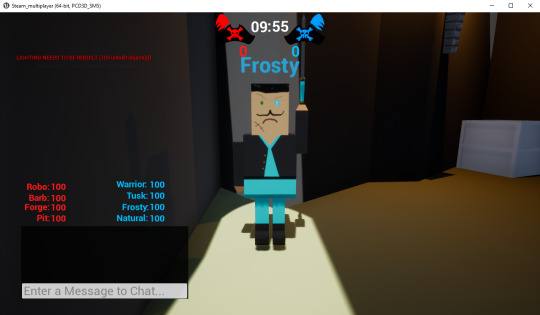
• Level Designing in UE4- My level designing skills have improved massively since starting at Futureworks
• Tell successful narratives- First year taught me a lot about narrative design and how to tell narratives in both games and in Twine.
• Gather feedback- I learned that feedback is vital in this industry and any piece of feedback could change the dynamics of an entire game or improve it dramatically.
• Work to deadlines- Although I had to work to deadlines at college, I feel that the deadlines at university are a lot tighter and stricter, as of which, I have had to learn to deal with them more professionally.
• Work both individually and in a team- I have learned how to work more efficiently as both an individual and a team for different projects and getting them finished efficiently and on time.
Self reflection
Main area of interest?
Level Design
Most enjoyable creative disciplines?
Level/ world building
Narrative writing
Blueprinting in UE4
Strongest skills?
Creating fun games
Perfectionist
Meeting deadlines
Working in a team
Self motivation
Technically: Designing worlds/ Blueprinting
‘Get a bit of freedom with your designs. Sure, the Game Designer and the Art Lead will tell you the theme and the art direction of the game, but you’ll have wiggle room to create within that framework.’
Level designers and editors can also be tasked with developing the gameplay of a level. In a genre like platformers, you’ll be designing a large part of the challenges that players of the game will face.
Kind of environment enjoy working in?
Enjoy working in a team if ethos is right
Enjoy solo tasks
Long term ambitions
Ship a game people want to play
Work for a company I am happy at
Challenging but fun projects
Working with charismatic and hard working people
What required to achieve them?
Keep working hard
Apply to places who make games I enjoy playing
Apply to places who make games similarly to what I enjoy making
Keep honing skills
Ethos: Everyone wants to work
Everyone working towards same goal
The beliefs of the game creating are similar to mine
Considerations
Location
Would like to be close to family
Prefer to be near countryside to city
Other commitments
Friends and relationship
Particular studios
Double Eleven
Ubisoft
Sumo Digital
Other avenues (networking/ competition)
Game events such as EGX, Manchester Gamer Unite or Tranzfuser

Research: How can you get to the job want?
• Begin as Junior Level Designer
• Move to Level Designer
• QA
• Graduate programs
• Indie companies
• Mods
Is it achievable?
These are the most common ways into this position.
Gabe Newell- “Traditional credentialing" has little "predictive value" to how successful someone will be or what they can do with their skillset.
Valve have hired people based on their mods (Team Fortress 2)
Gabe Newell- What he is saying here is that you could have the best qualification in the world, but if you cannot do the required work, not going to fit.
Do the work, more likely to get the job.
Pretty much every studio requires a level Designer
Rob Kay (19 years in the industry)
Lead Designer of Guitar Hero & Rock Band.
• The best training is definitely to make your own game/s, ideally small ones.
• Being capable of actually making (and not just designing) games.
• Getting your first break in the industry can be tough, but also totally doable.
• Everyone has a story of persistence towards their first break.
• Don't take rejections personally, stay positive, and be persistent.
• A University degree makes it easier to get first break.
• Starting in QA is the classic route into the industry due to "cultural fit“.
• Another route is to offer your dev services for free - i.e. intern.
• Game design is as much craft as theory
• Small games- You can make more faster and learn faster as a result. As almost every studio these day's uses Unity or Unreal, so I'd recommend focusing on one of them (probably Unity given it's the most popular and you've already got started on that learning curve). It's good that you're doing some scripting - I'd recommend doing that in Unity. If C# or JS are too much, look at Playmaker - a visual scripting plug-in for Unity (I've used this on 3 games now, and recommend it highly).
• Making games as well as designing also wins you huge kudos from skilled artists and coders.
• Spend time honing craft
• Learn crafts through practice.
• Even seasoned professionals have to deal with rejection
• They do this because there is usually a far higher demand for each entry level job position than the hiring manager can deal with, so they have to add requirements like "University degree" just to filter weaker candidates out and get a smaller pool of candidates. This is tough on people who have strong skills but no university degree of course, but it's the reality. By all means apply for positions asking for a university degree (it's so low cost you may as well) but don't rely on this path. Typically a recruiter will filter you out of the running for not meeting requirements before a hiring manager even has chance to see your resume.
• I know many many developers (inc game designers, producers, and programmers) who got their break at a game studio in the QA department. It's a great way to get to know people in the company / industry, and usually hiring managers at the company find it safer to promote someone internally from QA, than take a risk on someone entirely new to them, even if the outsider is more qualified on paper.
• So if they can show some design / dev skills, they're seen as a good bet and will get onto hiring managers radars. From what I can glean from your email, I'd recommend applying for QA positions - with the career strategy of transitioning into game design once you're in
• I knew a self trained 3D artist who got his break this way. He basically pestered his way into an interview, by visiting our studio at Infogrames Manchester with his portfolio everyday and offering to work for free. My manager at the time, said no several days in a row, but this guy kept coming back and politely offering to work for nothing. Eventually my boss asked the rest of us artists to check out his portfolio, and asked if we felt he could do anything for us. His portfolio was only average, but he seemed so willing and capable of some jobs and we had a lot on our plates, so we said yes. He's now been in the industry for 16 years (here's his LinkedIn). Persistence and a willingness to learn may be your biggest assets.
Key designer
Max Herngren (Level Designer)
• Student of game and level design at Futuregames, Stockholm
• Worked at Right Nice Games (Indie studio) as a Level Designer.
• Level Design intern at Mojang
• Level Designer at Mojang in Sweden
• Skylar & Plux: Adventure on Clover Island – Game made
• The Solus Project, a survival exploration game where I helped out at the end of the game’s development along with some other students in my class.
• Key Designers
Fundementals
• Have great sense of pacing and player experience
• Understand what a player wants at any given time
• Understand how they’re affected by the pacing curve
• Master composition
• Have an artistic eye
• Analyse games
• Flexibility
• Be able to do background work
• Use mechanics and space wisely
• What does it take to secure role of choice?
• Composition to guide a player through the space
• Won’t be able to make a level look appealing
• Guiding players arguably the most important thing to do
• Take it from me, you don’t have to be able to draw or make 3D models but you have to have an eye for it. Building a good structure can give environment artist more idea of what you’re wanting to achieve.
• You have to intuitively be able to look at a space and have an idea of if it looks good or not and how you can make it better
• Analysing these games can give better idea of space and improve own levels
• If waiting for mechanics to be built, possibly become a tester or help the artists or scripters if required or keep building to the space and tweaking until feels right.
• Try to understand why they put that rock just there and why that cave is laid out in this or that specific way, and how would I have done it differently and what would that mean for the player?
• Coders and scripters working on grey whiteboxed level, as soon as events begin happening in the background, becomes a lot more alive which can inspire people.
• Learning how to make a set of mechanics work for 20 hours without the player getting bored etc. Keeping it fresh and interesting for the players.
Main objective:
• Pre-production: Build a good foundation and base
• Figure out goals
• Work out an initial strategy
• Draw out ideas
• Research
• Block out with BSPs
• Replace with actual assets
• Learn engine inside out
• From which you can later build the game into a sequence of levels that are good and make sense in the context of the game.
• Work out an initial strategy of how going to reach them
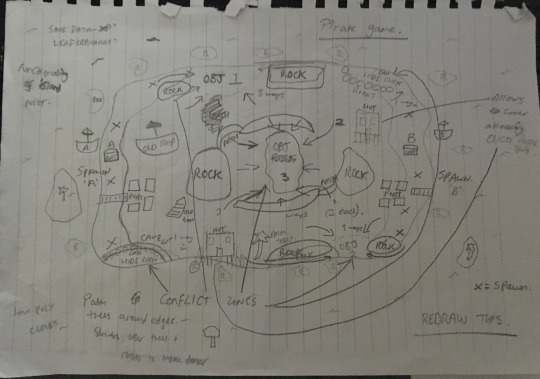
Best options:
Sumo Digital
Rockstar North QA
Ubisoft Graduate Program
Rockstar North tend to have a few openings asking for game testers and QA. As Rob Kay said, may be the best way in.
The Ubisoft Graduate Program offers successful applicants the chance to spend two years working on production teams in two different Ubisoft studios in order to hone their skills in a variety of professional disciplines, essentially making them employees.
The Ubisoft Graduate Program is a two-year international program for fresh Graduates who expect a career accelerator into the games industry. Over two years, Graduates will have the opportunity to work in two different studios in different countries.
Sumo Digital
Location
Sheffield
Near Peak District National Park
Team size
Around 250
What games do they make?
Little Big Planet 3
Helped on Forza Motorsport 7, Hitman Episode 5
Mission statement
‘Sumo make games we're proud of and passionate about: everything from driving games to platformers’
Main perks
Group Life Assurance Policy, Group Income Protection Policy, Holiday Pay,
Employee Assistance Program (EAP), Pension, Flexi Time, On site free gym, Days out.
Student placements
Internship
Reviews
‘Friendly atmosphere, good people to work with’ ‘Hands-off approach can make you feel like a small fish in a big pond’.
What kind of studios offer these positions?
Sheffield- Family not far away (1 and a half hours)
Peak District- Countryside and city is not as big as Manchester etc.
Team size: Mid sized company to gain the step into the larger one later on.
Fact that they make all types of games is interesting because would give opportunity to see what really enjoy making and make what I really enjoy playing.
Enjoy all types of games and they have helped create games I have grown up playing
The benefit is payable to a designated beneficiary in the event of death by a lump sum of 4 x annual basic salary.
The company provides a Group Income Protection Policy which protects the employee and their family for long periods of illness by paying a portion of income equivalent to 75% of basic salary, for a set timescale.
All employees will receive 24 days holiday, in addition to the UK Bank holidays.
EAP is a free, completely confidential source of support for employees and their immediate families, which is provided by a professional independent body.
The Company will provide access to a Group Personal Pension Scheme, administered by Scottish Widows.
Sumo offers a flexi time scheme, because we understand just how crucial it is that staff are able to maintain their work/life balance

What is missing/ lacking:
• Need to do more player feedback
• Show more refined levels with process
• Shipped at least one AAA 3rd person action title- Sometimes add this to filter candidates out.
• Hone proposal skills in order to get teams on board.
• Keep working on building games in UE4.
• Keep learning how to blueprint.
• What kind of studios offer these positions?
• What roles actually entail- what actually do
Over summer
• Update portfolio/ CV
• Create some games similar to Sumo and Ubisoft style.
• Have playable demos on Itch
• Get social media up to date
• Use other engines, e.g. Map editor in Far Cry.
• Keep honing skills in programs
• Keep time management structured
• Network
• Ensure games are at the forefront of portfolio
Update and work on honing skills in:
Website, Tumblr, LinkedIn, Twitter, Facebook
Programs such as PhotoShop, Maya and UE4
Bibliography:
Sumo Digital placements: http://www.sumo-digital.com/placements-emma-lintvelt/
Sumo Digital reviews: https://www.glassdoor.co.uk/Overview/Working-at-Sumo-Digital-EI_IE765707.11,23.htm
Sumo Digital website: http://www.sumo-digital.com/
Ubisoft Graduate program: https://news.ubisoft.com/article/ubisoft-graduate-program-2018-tips-from-our-ubigrads
Gabe Newell quote: https://www.polygon.com/2014/1/3/5270182/gabe-newell-on-hiring-modders-official-credentials-have-no-predictive
Get a job in video games: https://www.gamedesigning.org/career/jobs/
Level Design article: https://80.lv/articles/who-are-level-designers/
Max Herngren website image: https://maxherngren.squarespace.com/the-solus-project
Max Herngren website: http://maxherngren.com/about-1/
Rob Kay LinkedIn: https://www.linkedin.com/in/robkaysf
Ubisoft logo: http://logos.wikia.com/wiki/File:Ubisoft_2017.svg
0 notes